About John P.
One Man's Blog
Specialization is for Insects.

CatamaYak: How to Build a Kayak Catamaran

August 14, 2013 By John P.
We happen to own four identical kayaks, we bought the Equinox 10.4 kayaks at Costco, and we started working on ways to hack them to make them even better! First, I hacked a motor onto my kayak , and then I thought I’d give it a shot and see if we could build a catamaran out of a couple of em.
The CatamaYak Concept
When we go out on the water there is usually a group of us. Some are faster than others, and some just enjoy a leisurely time on the lake. We wanted to be able to turn a couple of kayaks into a floating relaxation station and give it a motor so that a couple of people could simply sit back and relax while still being able to tag along.
The CatamaYak needed to have a few important characteristics:
- be light and easy to assemble at the lake
- be extremely waterproof and not get slippery
- be durable enough to take a pounding from the waves
- be rigid enough to deal with the forces encountered
Given the design considerations I took a few measurements and drew up a quick sketch of the components and how I imagined they would fit together.

If you are going to design your own there are a few important things to keep in mind.
- The bow (nose) of the kayak is generally narrower than the stern (rear). So don’t just make the front and rear crossbeams the same length or it will look funny and not perform as well.
- You could substitute wood 2x4s for PVC in my design, but its not going to last as long and its going to flex and expand as it takes on water. Its also going to be a LOT heavier.
- If you intend to add a motor like I did you must make sure that the distance between the two kayaks in the center is sufficient for the motor to turn 360 degrees without the blades hitting the side of the watercraft.
The Kayak Catamaran Parts List
Everything I used for this experiment came from Lowe’s. I’m sure you could also find it at Home Depot or other home improvement stores.
- 3 – 10′ sections of 2″ PVC pipe
- 4 – 2″ PVC T sections
- 4 – 2″ PVC end caps
- PVC cleaner and cement
- 1 – 18″ x 72″ wood board
- 4 – 2″ stainless steel U bolts with lock nuts and washers
- 4 – 5″ stainless steel eye bolts with lock nuts and washers
- 1 – 8′ 2×4 (or a couple of 8″ scraps)
- 2 – 8″ 5/8×16 bolts with lock nuts and washers
- 4 – Ratcheting straps
I also needed a rubber mallet, wrenches, a drill, a set of drill bits, and a table saw. You could do without the table saw by having the store cut the wood for you.
Building the Kayak Catamaran
The first thing I did was set the two kayaks beside one another and lay the crossbeam PVC pipes on top of it. This allowed me to take measurements and make sure my design was roughly accurate.

It turns out that the exact finished dimensions worked perfectly for my kayaks and particular brand of trolling motor (Minn Kota 30 pound unit). See the design sketch above if you have Equinox 10.4 kayaks and want to exactly duplicate this build.
I then cut all the PVC pipes and dry fit the pieces. I used my table saw to cut the PVC, but you could use a hacksaw and do it by hand, or you could use a reciprocating saw or basically anthing with a blade long enough to go through 2″ of PVC. Its a very soft material so its easy to cut – but keep your cut very straight as you go. The pieces won’t fit properly if the cuts are all crooked.

Then it was time to attach the pieces. First, you must start with the rectangular center frame, and you have to be VERY careful when assembling this piece to make sure you get it extremely straight!
I carefully cleaned and cemented each fitting and lightly attached a T union to one end of the support frame. I then VERY QUICKLY laid it on the flat piece of wood to make sure the T’s were pointing straight. After a little adjusting I took a rubber mallet and pounded the T’s on as far as they would go.

You’ll know when the pieces are fully inserted because there is a little ridge in each connector or end cap that won’t let the pipe go any farther. So you don’t need to worry that you put it in too far. In fact, if you follow my design its extremely important that all PVC is assembled as tightly as possible for proper fit and structural integrity.
If done right you can look inside the T fitting and see there are no gaps and some of the cement is pretty much sealing all the way around the tube where they meet.

First glue up both end pieces, then attach the two long PVC supports to one end, and follow up by attaching the other end piece – which will require you to glue up two pipes at the same time. Work quickly as the PVC cement drys fast! And remember – HAMMER EVERYTHING TOGETHER WITH A RUBBER MALLET!
After that you’re in the home stretch. Time to glue on the cross beam pieces. These are the most critical joints so make sure they are very clean and you have plenty of cement. You don’t want these to break on the water! Also, notice again that in my design the front and rear are different lengths. Here is a photo showing just one side glued up.

Once you’ve finished connecting all the PVC joints and adding end caps, you can lay the frame back down on your kayaks and begin attaching the connecting hardware. First up, the wooden platform needs to be connected on top. This serves two purposes. First, it provides a lot of torsional rigidity. And secondly, it gives you a spot where you can put stuff!
I used 4 long eye bolts pointing upwards to connect the wood to my PVC frame by drilling down through the wood and directly through the center of each of the 4 T-connectors in the corners. By using the eye bolts it gives connection points in each of the 4 corners that can be used for lashing things to the top, or could even be used for lifting / hanging the platform.

You’re going to attach 4 eye bolts pointing downward from the end of each crossbeam. These are going to be used for connecting the ratcheting strap to hold the kayaks in place.

The other end of the strap mounting is a U bolt mounted directly on the platform. Make sure and leave enough room that the ratchet can be entirely on top when its mounted securely. This does a couple of things, but most importantly it allows you to ratchet it up a little while on the water if it loosens up, which it will do a bit when it gets wet. I’ve already proven out this point on the Lake, so don’t skip it.

You’re about done at this point! Now if you intend to mount a motor on it you need to add a wood block that will fit it. I accomplished this by cutting two 2×4″s down to 8″ wide. These were attached with several stainless steel screws and an L bracket (found near the fencing stuff in the lumber department) for some added rigidity. I wanted to make sure there was NO flex with the motor so all of the power translated to forward momentum instead of any wiggle in the mount.

At this point you should be done and ready to simply slip a ratcheting strap under each mounting point, front and rear, on both Kayaks and secure them tightly.
We took the double Kayak Catamaran out on the lake for the day and it performed FAR better than I ever expected! The little 30 pound Minn Kota trolling motor was able to EASILY push the watercraft! By the way, you need to really watch the video I did about the single Kayak motor mount in order to see how to wire it up and which battery to use, etc. But even with the little trolling motor battery I used we were out on the lake messing around with the motor in use for over an hour and only used 20% of the battery life.

Not only was this rig able to easily push and steer the CatamaYak, but we were able to even TOW both of the other Kayaks without any issue! Amazing.

A couple of last little things. You’ll see in all of the photos that the wood panel in the middle is exposed untreated wood. That’s because we bought some special textured extremely waterproof paint to cover it with, but I didn’t do it before the first trip out to the lake. We’ll be painting it for long term durability soon.

Finally, if you do this, you’re technically changing your kayak into a home built motor boat. And in Texas, and probably most states, you’re going to have to register it as a watercraft. It costs like $30 in Texas to do it, but be warned that if the lake police come by you could be ticketed for taking this on the water without registration. So make sure you’re covered so you don’t worry about it.
Oh, and be prepared for a LOT of attention on the water! Because no one has ever seen anything like this before so they’ll all want to be checking it out!
So, that’s it! I hope you guys enjoy the hack / build. Let me know if you have any questions in the comments below and I’ll help as best I can. This is a project that you can build in just a couple of hours if you have the right tools, and the entire cost was around $100 including PVC, wood, bolts, paint, etc. So that’s a pretty good value!
John P. is a former CEO, former TV Show Host, and the Founder and Wizard behind Texas Metal Works . You can find him on Twitter , Facebook and LinkedIn . Feel free to send shoutouts, insults, and praise. Or Money. Money is good.
May 11, 2016 at 9:30 pm
This is awesome! I am with Robert on the straps..confused about the role of the U bolts. I thought the ratchet strap hooked back to the platform eye bolt. Please clarify. By the way John, why did you take yours apart?
May 12, 2016 at 10:32 am
I used the u-bolts on the platform so that the base of the ratchets could lay flat against the wood once everything was tightened up. This way when you’re on the water you can use one hand to ratchet it tighter if need be.
You may be able to use the same I look somewhere and put both ends of the ratchet on it. You just want to make sure that you have enough room for the straps to Route Around everything and still be accessible when you’re on the water. It could be fairly disastrous to have anything separate with your stuff on that Central platform. It would pretty much just think…
I disassembled mine because I wasn’t going to register it as a watercraft, and it takes up too much room in the garage for something I’m not using constantly. If we had a lake house I would have definitely left it hooked up. It was great! :-)
December 14, 2015 at 5:37 pm
This is something I have been wanting to do for a long time. Great instructions. One thing that isn’t clear to me is how the ratchet straps attach to the u-bolts. Could yo show a top view picture to make it easy to see? Thanks.
January 5, 2016 at 10:59 pm
Sorry Robert, I took it apart a while back so I can’t take a photo any more. But since the ratcheting straps have hooks on them, as long as you get them hooked into the eye bolt and just tighten them up, they’ll stay! :-)
April 10, 2015 at 10:53 am
Great modification! I have 2 identical Perception Sport Pescador 120 kayaks and this has definitely inspired me to build a similar setup. I also own a Hobie Adventure island and love the extra space gained from the trapoline sides between the kayak and the amas (just like your wooden platform has done). You could also add additional cargo space to the void formed between the wooden platform and the front of the two kayaks from a lightweight water repellent material. Great work, thanks for sharing!
July 14, 2014 at 9:27 am
I wanted to say thank you for posting this project. My son is handicapped and i had wanted to take him our on my kayaks and could not imagine how to make it safe for him to enjoy. This is perfect. We even got a thumbs up from the Vessel Assist Boat Crew on our Maiden Voyage. The stability is amazing even in Lake Washington with the chop and larger motorized vessels. Your measurements were spot on for our boats. High Five! Would love to share a pic. This has opened up a whole new world to a boy and his dog. Thank you!
July 23, 2014 at 11:30 pm
Yeah! I’m so happy to hear that this was helpful! :-)
August 15, 2013 at 8:33 am
That definitely seems easier than I thought.
August 14, 2013 at 2:40 pm
I was going to say if John built it a Catastrophe but it looks pretty good. Cali has large feet or John has small ones. :)
August 14, 2013 at 1:10 pm

A Complete Catamaran Guide
- Post Written By: Boater Jer
- Published: January 26, 2020
- Updated: November 27, 2020

Disclaimer: You might notice that we recommend products in some articles. We may earn a commission for referring you if you click the link and buy a product.
We only recommend products we’ve tried/tested/own (that’s why you won’t find thousands of affiliate links on my site). If you have experience with one of the products we’ve mentioned, please share your experiences in the comments at the end.
There you are, out on the water when a strange craft approaches. Is it a sailboat? It sure looks like one until it turns to face you. That’s when you notice this boat doesn’t have just one hull. It has two hulls and it’s called a catamaran.
Catamarans are unique, and highly stable watercraft. We’ll explore all the ins and outs of sailing the waters in one of these weird, and awesome multi-hulled craft. Join me as we explore the wild world of sailing catamarans.
A History Of The Catamaran
It is believed that the first people to use a catamaran design were those living in Australasia.
The succession of boat design in this region was actually very interesting. The beginning of boats in the area was simple, albeit conventional rafts. These were fashioned from logs strewn together with plant fiber lashings such as those formed using bamboo fiber.
Catamaran Evolution
The conventional raft gave way to a minimal raft. This design was basically a conventional raft with two cross beams added in the form of logs. These would be eventually hollowed out to improve buoyancy.
The next step in the evolution of boats in the Australasian region was the double canoe. This proved to be the first real catamarans.
After some time, the form evolved further into the asymmetrical double canoe design. In this design, one canoe was large and the other attached canoe was smaller.
The asymmetrical design quickly evolved into the single-outrigger boat like the one shown in the photo below.
The final stage of the evolution of the catamaran in the region was to gain a second outrigger. This in effect created the trimaran with the single central hull and dual outriggers.
Eye Witness Accounts Of Catamarans
In 1697, William Dampier wrote of witnessing a type of seafaring vessel off the coast of Coromandel. He noted how the locals called the type of boat a catamaran. He also noted that it had multiple hulls (logs) and that they were small vessels that the person operating would have to hang partway into the water, straddling the hull (log).
The name catamaran came from the Tamil. And yet, it was easily applied by the European visitors to the two hulled sailing vessels that sped across the water in the region.
Although Dampier may have described the catamaran in the 1690s, the type of boat was actually used as early as the 5th century by the Tamil Chola dynasty. They used boats to move their troops from one island to another. Using this design of boat allowed them to travel heavy, travel quickly and was partially responsible for the conquering of neighboring Burma, Malaysia, and Indonesia.
Building A Boat – Basics Of Catamaran Construction
A boat is usually thought of as being a single-hulled vessel that travels along the surface of the water. It can have multiple types, shapes, and designs of the hull. However, it is often only thought of as having a single hull. But, what if it had two hulls? Would that be like taking two separate boats, and making a raft over both of them? In essence, that is exactly what a catamaran is: two boats made into one.
Advantages Of Multiple Hulls
- More stability than a monohull
- Wide supporting base allows for larger sails than monohull craft of the same length
- Hull does not require the deep-running keel of a standard monohull sailboat
- Less hull drag in the water than a monohull
- Less power required to drive a catamaran forward than a monohull boat
Disadvantages Of Multiple Hulls
- Due to multiple hulls, construction is more expensive than a monohull design
- Catamaran speed relies on lightweight materials to make a lightweight craft. This also drives up the cost of construction.
- Extra engineering requirements for multi-hull craft also increase the cost of construction.
Conclusion? Well, it looks to me like everything about catamarans points towards superiority over monohulls in nearly every way. But, you get what you pay for. I think the same thing likely applies to cars too. For instance, I have a performance car that cost me about 10k more than the equivalent non-sports car within the same class.
Yet to drive the vehicle, it performs so much better than the normal version of the car, it really speaks volumes to the difference between a common vehicle, and a performance one.
Speaking of performance vehicles, let’s take a look now at the different kinds and uses of a catamaran.
Catamaran Types
Commercial catamarans – ferries.
One of the most common uses for a catamaran is the commercial use of the vehicle design when it comes to ferries. This is likely due to the wide, flat deck possibilities of a catamaran versus a monohulled boat. Not only that, but the catamaran is also a much more stable bodied vessel. This again makes it a superior design for transporting larger land vessels like trucks and so forth. They can easily drive on the ferry without fear of the ferry tipping over.
Some ferries are designed for taking vehicles, like the one you might find in the city of Toronto. Where it transports cars from the mainland to Toronto Island. Others are designed specifically with the sole purpose of transporting people. I took a look at one such ferry that operates in Germany. Take a look at the following case study.
Commercial Use Case Study – The Ferry
The FRS Helgoline is a ferry catamaran operating out of Flensburg, Germany, close to the Danish border.
According to the ferry company’s website, the ferry runs using four main engines which are run to a capacity of 12,182 hp combined. This blasts this ferry at a speed of 35 knots or 65 km/hour. This is equivalent to 40 miles per hour. That’s pretty good considering the size and weight of the ship body this catamaran can carry.
Speaking of capacity, the ship can carry 680 passengers. At 56.4 meters long (185 feet) by 14 meters wide (45.9 feet), that’s a decent passenger capacity.
Catamaran Passenger Capacity Versus Monohull Boat Passenger Capacity
The general rule for calculating passenger capacity for a boat is as follows.
Length x Width / 15 = Passenger Capacity
Therefore, the FRS Helgoline should have a calculated capacity calculated as follows.
185 x 45.9 / 15 = 566
But it actually has a capacity of 680 which is a 20% increase in capacity over a standard monohull.
For comparison, let’s look at a superyacht. A 48.5m (159 feet) long by 10.7m (35 feet) beam (width of the boat) Palmer Johnson Supersport 48 (valued at about $28.5 million dollars) should have a capacity calculated as follows.
159 x 35 / 15 = 371
In short, 26 feet of difference in length equates to 309 fewer passengers. It is almost half of the capacity of the catamaran at 26 feet longer length.
Photo courtesy of https://sysyachtsales.com/
Commercial Catamarans – Service Vehicles
Although Catamarans are typically used as ferries due to their stability and ability to carry wide loads on their flat decks, there are many different service catamarans out there as well. From a support vessel to a crew transfer or search and rescue, catamarans are a solid and stable platform to build a ship on.
This is the Ardea which is a 20 meter (65.6 feet) catamaran to be used for crew transport and as a support ship. This ship was built by the Echo Marine Group and delivered to Western Australia in early 2019. This particular vessel is in the service of the Cape Preston Sino Iron Project.
Catamarans are used all around the world, for a variety of tasks, not just ferries or support craft.
Commercial Catamarans – Cruise Lines
Now these are the catamarans we all want to be aboard, aren’t they? Due to the wide stance, these ships can feature massive halls and wide-open interior areas. These ships are stable, and some would say even more stable and safer than monohull design ships.
There are many cruise ship catamarans in use today around the world. Some of the more ‘famous’ catamaran cruises are those which investigate the Galapagos Islands. There are several high-end, small fleet, cruise lines operating to the Galapagos which utilize catamaran design vessels as their primary ship type.
These ships can be extremely comfortable and stable and often offer some reprieve to those who may otherwise feel seasick. It won’t stop the feeling, but the more stable the hull, the less the boat rocks around.
Military Catamarans
Catamarans make excellent military transport vessels. They are stable and the potential to have a large, flat and wide deck for transporting land craft, troops or acting as a landing pad for vertical take-off aerial craft. The stability of the two hulls makes the vessel an excellent candidate for military use, and thus it is used for said purpose.
As you can clearly see in the image of the USNS Spearhead, the rear of the vessel has a moveable ramp that can be used for loading and unloading land vehicles. The interior bay of the craft is visible in the image as well, a large area for storage of vehicles, supplies and more. The crane arm on the back of the ship also shows how it is a versatile craft, set up to act as an excellent support craft with a helicopter landing pad and ample storage and freight capacity.
Recreational Catamarans
Catamaran Personal WatercraftThe wind is in your hair, the warm spray from the hull cutting over the edge of each wave as you skip over the water. That is life, let me tell you. Personal watercraft have come a long way over the years and the small one, two, three and four-person catamarans have come a long way as well.
Depending on the options, you can get a small one or two-person catamaran for as little as $1500 new. That might be an inflatable though. There are some very nice, rigid hull designed catamarans for 1-4 people that range from $3500 to $15000. And these are basically open, personal watercraft like that shown in the image below.
Using a small catamaran can be quite challenging to learn at first. Sailing is not for the faint of heart. It requires skill, technique, knowledge of the wind and sea, and a bit of hard work. But it can be fun, rewarding and a great way to catch some sun and fresh air out on the water. It’s a relatively GREEN sport as well. Given the use of sails over gas-powered motors that is.
‘Sailing Cats’ – Sailing Catamarans – Yacht & Luxury Class
Here’s where we get into the dreamy boats of the rich and famous. I priced out a small 43’ luxury Leopard 40 sailing catamaran. Even before I added any extras at all, the base price was $399,000 USD. I imagine if I added a few of the multiple extras available, and some tax, freight and that sort of thing, I’m easily in half a million dollars. And that’s the smallest base model.
There are all kinds of luxury catamaran shipbuilders across the world. From Asia to Europe and The Americas, it seems any major boating country has at least one company building luxury catamarans. It’s weird that you don’t see more of them on the water though, don’t you think?
Being sailing vessels, these luxury cats require some training in sailing before you get behind the wheel. And considering the price point, I would definitely want to be at least a semi-decent sailor with some good few years experience under my belt before I would comfortable at the helm of a half-million-dollar sailing cat. It’s all relative I suppose. I imagine a billionaire might bat an eye at the prospect of wrecking a half-million-dollar boat. But to me, and most of you reading this, that’s likely a lot of money.
‘Power Cats’ – Powered Catamarans
The powered catamaran is one of my favorite boats. They have sort of a muscle car appearance with the wide and often tall front end of the boats. I find it to be reminiscent of a large air intake on the front hood of a rally race car like the Subaru WRX, for instance. These boats are fast, they are stable and handle very well. Catamarans are often considered the boat of choice for long sea voyages due to their stability.
A powered catamaran will definitely cost more than a powered monohull boat of the same length. Why? Well, the powered catamaran has one crucial downside. That is, it needs two engines. One for each of the two hulls. Otherwise, it’s off balance for propulsion. These two engines or motors have to be in sync with each other or again, the propulsion will be off-balance. Because they have two motors, they have double the maintenance when it comes to maintaining the propulsion system.
More components also means a greater chance of things breaking down. In essence, it doubles the chances of the ship having a motor break down. The saving grace is that should one motor break, they have a backup, even if it does mean very unbalanced propulsion. In contrast, a monohull vessel of the same length may only have half the chance of motor failure due to only having one motor, but if that one motor breaks, then what? Call for help, that’s what. A cat would have a struggling chance to get itself back to port. A monohull would be dead in the water unless it was carrying spare parts or another motor onboard somewhere.
Catamaran Frequently Asked Questions
What is a catamaran cruise.
A catamaran cruise is simply a cruise on a dual hull design boat. Often used for river cruises, the catamaran which is used as cruise ships are often considerably smaller than their giant monohulled counterparts.
What is the purpose of a catamaran?
A catamaran is a design for a boat that utilizes two hulls. Due to the flat, platform-like-potential for the deck of the boat, the catamaran is often purposed with transporting materials, vehicles, and people. For instance, catamarans are quite often used as ferries.
Is catamaran safe?
Catamaran are very safe water craft. The design of riding on two hulls separated by a gap in between, in essence is like giving a car a double-wide wheel base. The wider the stance, the more stable the craft, from side to side anyway. And if the length of the boat is proportional to the width, then it becomes an extremely stable craft. That is why catamarans are often considered the best to be used for long voyages. Yes, catamaran are safe.
What is the difference between a catamaran and a sailboat?
A traditional sailboat is a deep, monohull vessel that has at least one mast extending high into the air above the deck to hold sails. A catamaran refers to the design of a dual-hull boat and really has nothing to do with sails. Although, catamaran do make excellent sailing boats as well, they are quite capable of acting as power boats and do not require sails if they have the correct amount of powered motors to propel them. Sailboats, although also able to be powered if a motor is provided, are traditionally monohull and wind-powered exclusively.
Do catamarans have small interiors?
The size of an interior cabin on a boat is typically proportional to the size of the boat itself. If a catamaran has above-deck cabins, they will likely be able to be of a larger design than those you would find on deck of a monohull boat. This is because a catamaran has a much wider footprint than a monohull boat of the same length. This extra width would allow for larger on deck cabins.
How much does a catamaran cost?
A personal watercraft (1-2 person) inflatable catamaran will run you anywhere from $1500-$12000 USD, depending on the quality and features. The rigid hull catamarans of the same size start at about $4500 USD.
A small cabin cruiser type of catamaran will typically start at about $60000 for a small base model and the price just goes up and up depending on size and features.
For Instance, a 40’, 3 cabin with 1 washroom cat will cost you about $500,000 USD for the base model. They are considerably more expensive that a monohull of the same length. However, the trade-off is greater stability and a smoother, more comfortable ride.
Is a catamaran more work to maintain?
Technically yes. Due to having two hulls and if powered, two motors and likely also water jets, this means you have double the oil changes of a boat that would have a single motor. Once you get past the basic engine and hull maintenance, a catamaran is not that much more work than a monohull ship of the same length.
The trouble with catamarans in terms of maintenance, is that once they reach a certain length, the width becomes more than a standard lane on the road. That being said, if you ever need to transport the boat via land, it can be quite the challenge. Especially if you need to pay to have a police escort for an extra-wide trailer. And special licensing might be involved as well.
What is the difference between a catamaran and a trimaran?
A catamaran is a dual hull boat. In other words, it has two hulls. A trimaran has three hulls.
Is a catamaran considered a yacht?
According to Oxford dictionary, a yacht is a medium-sized sailboat equipped for cruising or racing. A catamaran, on the other hand, is a boat with two hulls. Therefore, a catamaran can most certainly also be a yacht. And likewise, if a yacht has two hulls, then it is a catamaran as well.
Can you get seasick on a catamaran?
Seasickness occurs when a person feels nauseous from the swaying motion of a rocking ship. These feelings may be lessened on a catamaran, due to their extra stability. However, a catamaran may be slightly more stable than a monohull of the same length, but it is still a boat. And it will still make someone who experiences seasickness continue to feel the ill effects.
Are catamarans more stable in rough seas?
Catamarans are known to be more stable than monohull ships of the same length. This is why catamarans are often the ship type of choice for long sea voyages due to their stability.
Why do catamarans capsize?
Catamarans are not known for capsizing. The larger vessels that is anyway. But, it does happen from time to time. Catamarans are known for their stability, so typically if a capsize event should occur, it is typical for them to be extreme circumstances.
Personal watercraft catamarans are a different story though. These are in fact known for tipping over. Not because they are less stable than their monohull counterparts of the same length. But instead, because they are able to go considerably faster than monohull personal watercraft of the same length (not including powered craft though). This is due to the sailing cats being able to have a larger sail than a small monohull sailboat of the same length.
Due to the extra sail, they are able to travel faster than monohull sailboats of the same length. This allows them to whip around on the water and at higher speeds, whipping your cat about quick can easily send it over sideways. Extra speed means fast turns carry momentum in the direction of travel and that extra speed equates to tipping over if turned too fast. To sum up, they capsize due to user error or extreme events.
Which is safer, a catamaran or a monohull?
Due to the extra stability of having a wider footprint than a monohull, a catamaran of the same length is the safer vessel.
Are catamarans safer than sailboats?
The same rule applies to stability versus the length of the hull. A cat will always be the more stable length for length. However, due to their ability to go much faster than a monohull sailboat, this kind of cancels out some of the added safety due to stability. With that in mind, they may just be about the same but there is one generalization we can make when comparing the safety of catamarans vs sailboats: At the same speed, and of equal length, sailing or power catamaran will be safer than a monohull sailboat.
How fast can catamarans go?
The speed a catamaran can go is entirely dependent upon the hull design, weight of the vessel, the strength of propulsion (be it wind or powered) and so on. The general rule is that in terms of sailing cats vs monohull sailboats, a cat of equal length can typically go faster than a sailboat.
In terms of powered cats vs powerboats, a powered catamaran will typically require less energy to move forward than a monohull of the same sort of hull design (but monohull of course) and thus a cat should, in theory, be able to go faster than a monohull when both are using propulsion that is equal in power.
Bibliography
- Wikipedia – Catamarans
- Mahdi, Waruno (1999). “The Dispersal of Austronesian boat forms in the Indian Ocean”. In Blench, Roger; Spriggs, Matthew (eds.). Archaeology and Language III: Artefacts languages, and texts . One World Archaeology. 34 . Routledge. pp. 144–179. ISBN 0415100542 .
- Wikipedia – Spearhead -class expeditionary fast transport
- https://www.tiki-toki.com/timeline/entry/169516/Origin-of-the-catamaran/#vars!panel=1620923!
- https://www.austal.com/ships/passenger-express-56
- https://www.adventure-life.com/galapagos/galapagos-catamaran-cruises
Boating Gear
Take a look at our Recommended page for a variety of items. Here are some of the things you can expect:
- GPS And Fish Trackers
- Hitch And Trailer Supplies
- Lifejackets And Specialty Clothing
- Boating Books And More!
More From Boating Guide Magazine
- Pontoon Boat Basics
- The Complete Runabout Boat & Trailer Towing Guide
- Winterizing Your Boat
- Boating Gear Requirements For Canada And USA Waters
- Aluminum vs. Fiberglass Bass Boats
- Better Boating At Night & How To Survive The Darkness
- Staying Safe On A Catamaran: 24 Essential Tips
- Can A Catamaran Capsize?
- 4 Common Types Of Propulsion For Boats
Return To Home * About Boating Guide * About The Author
fakewatches.is
Share this post with your friends.
- Tags: boat type , catamaran , catamaran basics , catamaran essentials , sailing
Subscribe to our Newsletter
Join us in our love for all things water. And Adventure.

Why Are Boat Steering Wheels So Big?
You see them on the water in summer or all year round, depending on where you live, boats, and lots of them. Riding on the water on a ship is calming and relaxing unless you are racing, then it can be exhilarating and action-filled! I have been on many boats of different shapes and sizes.
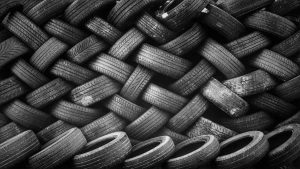
Boat Trailer Tire Guide
A boat trailer tire is something that is neglected by most everyday people. In other words, a tire is an underrated part. However, the main question arises that is a tire underrated, or is it just a myth? This section deals with the factors and facts that are related to the boat trailer tire. It’s
A Snapshop Guide To Boat Buying
A Guide to Buying Boats for a Smooth Sailing Adventure Looking for the ideal boat can feel like an arduous adventure. To begin your boating journey, a boat must be suitable for your requirements in terms of the quantity and quality of its lodgings, speed, maneuverability, overall look, and affordability based on your budget. Assuming

Does Marine Grade Plywood Warp and Rot? Is it Waterproof Plywood?
Updated April 27, 2021. Working on a boat build is a great and time-consuming endeavor. The last thing a boat builder wants is to use materials that will not be conducive to a wet environment. Moreover, one is likely asking the question, “Does marine grade plywood warp and rot?”. Although marine plywood avoids warping and

Boat Repair- The Truth About Eisenglass Vs. Vinyl
If you’re a boat owner, you must have come across eisenglass vs. vinyl. Yes, they’re world-famous materials used to make clear glass windows. Since they’re thin strips and durable, they don’t take up much space in the boat. However, when repairing the vessel, you might want to reconsider whether to install eisenglass or vinyl. Wondering

A Guide To Boat Seat Re-Upholstery Costs
Boat Seat Re-Upholstery isn’t as tough as you might think. Boat seats can receive damage from direct sunlight, rain, moisture, water, etc. Re-upholstering is the best way to recover your existing boat seats. Re-upholstery can be cheaper than replacing the entire boat seats, and you can either hire a professional or do it yourself. But

Boat Information By Type
© 2023 Boating.Guide, A Hyperwave Media Group Ltd. Publication.
Privacy Overview

Your Guide to Catamaran Kayaks
11th Jun 2024
Table of Contents:
Understanding the catamaran design, types of catamaran kayaks, flip-kat®: revolutionary catamaran kayak design, practical tips for catamaran kayaking.
A catamaran kayak, like the Flip-Kat®, has two hulls. This design has been around in boats for over 3000 years. Beginning with Polynesians, they were made for long voyages across the sea. Catamaran kayaks are now increasing in popularity. People enjoy the stability and comfort that these kayaks offer. There is more storage space and much more capabilities that catamaran kayaks offer than traditional kayaks.

There are a couple of key features to look for in a catamaran kayak, one being the dual hull. The hull provides much more stability than traditional kayaks .. Also, be sure to look for the propulsion system in these kayaks. Some kayaks are paddle-powered, while others can use a pedal power system.
Catamarans are known for being large, stable, and typically more safe than other hull styles. The hull construction has tons of benefits. Typically, catamaran hulls allow for faster travel, can navigate better in shallow waters, and create a more stable vessel than any monohull design. The key feature that stands out with a catamaran hull is its stability. Most concerns with traditional kayak hulls are the lack of stability while standing or in rough seas. Catamaran-style hulls provide more stability and comfort while kayaking.
Fishing & Hunting Catamaran Kayaks
These are designed for anglers and hunters. Stability is one of the most essential factors while hunting and fishing, and the catamaran hull provides this stability. This stability allows standing up to cast a line or take a shot without tipping over easily. These kayaks often have features like rod holders, gear storage, and even mount points for trolling motors or anchor systems. They are ideal for those who are searching for the ideal kayak for fishing or hunting .
View this post on Instagram A post shared by Noisy River Outdoors (@noisyriveroutdoors)
Recreational Catamaran Kayaks
Catering for general leisure, recreational catamaran kayaks are great for day trips, casual paddling, and exploration. They are typically more comfortable and easy to maneuver. The dual hulls provide a stable base, making them a good choice for beginners or those who prefer a relaxed kayaking experience. These kayaks offer a pleasant and safe way to enjoy the water, whether on a lake, river, or coastal area.
Portable Catamaran Kayaks
These kayaks are designed for convenience and ease of transport. They are usually lighter and collapsible, allowing them to be easily packed and carried to remote locations or stored away. Portable catamaran kayaks maintain the stability characteristic of the catamaran design, but prioritize portability and ease of assembly. They are ideal for those with limited storage space, who want to kayak while traveling, or who need to hike to access water bodies.
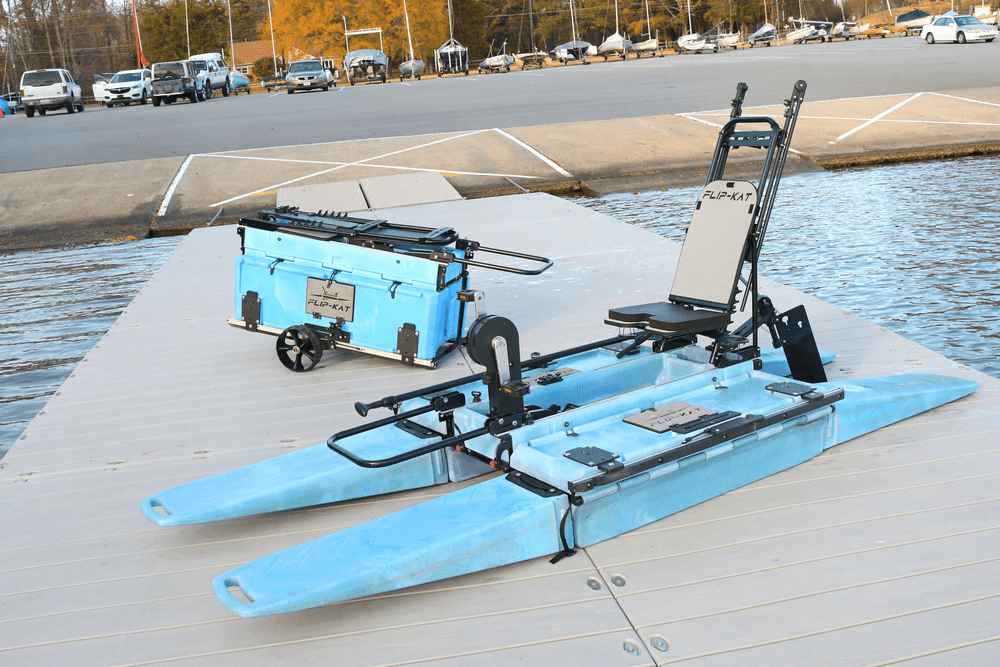
The Flip-Kat® is the first of its kind, offering a custom-designed catamaran-style hull while being completely portable. It folds up to be a portable solution to storage and transport issues that arise with other designs. The Flip-Kat® design is quick and easy to set up, transforming from a compact cube into a full-sized kayak in minutes. The Flip-Kat® has adjustable seating and a pedal drive system, ensuring the best ergonomic comfort on the water. It is also made with super durable materials perfect for various water conditions while maintaining a lightweight design for easy handling.

The Flip-Kat® has many different customization and accessory options, allowing you to create a kayak that fits your needs. If you plan on mostly fishing, you can add rod holders, fish finders, and even a Bipxy motor to get around faster. The Flip-Kat® was designed for the user to make it their own. The Flip-Kat® can be customized to your desires, from leisure to serious outdoor activities.
Benefits for Different User Groups
There are tons of different outdoor enthusiasts who pursue joy in their own way. The Flip-Kat® fits every single passion perfectly. For example, for photographers looking to capture scenic wildlife, the catamaran hull proverbs the needed stability to get that perfect shot. The safest option for seniors who want to enjoy life on the water is the Flip-Kat®. The catamaran hull gives an ease of mind to elders looking for a stable kayak. The pedal drive system also provides more power and maneuverability for all users. For leisure kayakers looking for exercise and fun, the Flip-Kat® is the perfect all-around kayak for any day out on the water.
Portability and Storage
The Flip-Kat® kayak excels remarkably in storage and portability, distinguishing itself as a top choice for enthusiasts and casual paddlers. Its ingeniously designed collapsible structure allows it to be easily folded to a compact size, making it incredibly convenient to store in tight spaces, such as apartment closets, car trunks, or aboard boats. This feature is a game-changer for those with limited storage options. The catamaran hull design creates a space for storing any gear or safety equipment. Whether traveling to a nearby lake or embarking on a distant adventure, the Flip-Kat® simplifies the process, making it effortless to bring your kayak along.
Advanced Features of Catamaran Kayaks
There are a couple of features that make catamaran kayaks much better than other options. On the Flip-Kat®, the pedal-drive propulsion system creates an efficient form of transportation. While pedaling, you will sit in the wholly adjustable and ergonomically designed seat. This is amazing. It lasts for long days and adventures out on the water. The Flip-Kat® is also completely customizable. You can add compatible accessories to enhance your kayaking experience.
Choosing the Right Catamaran Kayak
When deciding what catamaran kayak you want to buy, make sure you consider different factors. These could include the cost, the design, and materials for the kayak brand. There are a few other options, so be sure to do research before purchasing your kayak .
Safety and preparation are paramount in catamaran kayaking: always wear a life jacket, check weather and water conditions, and understand your kayak's features. Carry essential safety gear, inform someone of your plans, and be equipped for emergencies. When navigating, adapt to the environment; in calm waters, focus on technique and balance while in rougher conditions, be mindful of waves and tides, and kayak within your skill level. Training and respecting the water's dynamics are critical to a safe and enjoyable kayaking experience .
Eco-Tourism & Environmental Impact
Embracing eco-tourism in kayaking means choosing sustainable materials, adhering to 'leave no trace' principles, and opting for human-powered kayaking to reduce environmental impact. Responsible exploration requires awareness of the local wildlife and ecosystems, maintaining a safe distance from wildlife, avoiding disrupting natural habitats, and following designated routes to minimize your footprint. Educating oneself about the environment enhances conservation efforts, ensuring a sustainable interaction with nature during your kayaking adventures.
Future Trends and Innovation
Innovations are always coming into the kayaking and outdoor scene. Tons of technological advancements can enhance your experience out on the water, whether that be combining a solar charger with an electric motor or just having advanced fish finders. There are tons of new things that make kayaking more fun.
In summary, the evolution of catamaran kayaks, epitomized by the Flip-Kat® , represents a perfect blend of traditional stability and modern convenience. These kayaks cater to various needs, from fishing and photography to leisurely exploration, while offering remarkable stability and comfort. The Flip-Kat® particularly shines with its portability, ease of storage, and customization options, making kayaking accessible and enjoyable for all enthusiasts. This kayak encourages responsible enjoyment of nature's waterways. With ongoing innovations, the future of kayaking looks promising, ensuring a sustainable and exciting experience for all. The catamaran kayak, especially the Flip-Kat®, symbolizes the seamless integration of human innovation with respect to the natural environment. Order your Flip-Kat® today!
You Found Our Blog! Enter to Win a Flip-Kat™
To celebrate our pre-launch we are giving one lucky individual their very own Flip-Kat™. Enter below!
I Want to Win a Flip-Kat™!
Item Successfully added to comparison list.
Item Successfully removed from comparison list.
At least 2 products are needed to make a valid comparison.
- Catamaran Canoe Trip

Canoe Trip For the Family with Small Children
Why a Catamaran Canoe Trip?
Over the years many parents have asked us, “What is the average age of children before parents will start bringing them on Boundary Waters trips?” On average we would have to answer about 10 years old. But there is no height limit like at the amusement parks, and there is no age limit. It all depends on how comfortable you are with your canoeing, camping, and survival skills and whether you feel that you would be able to take care of your children when the conditions become less than ideal. Kids under the age of about 14 rarely carry their own weight while on a canoe trip. And where this becomes an issue is when a young child has to be the bow paddler in a canoe. But not anymore. We want you to be able to experience the Boundary Waters with your young kids without the worry and anxiety of swamping your canoe. So we’ve developed the “swamp-proof” Catamaran Canoe to help put your worries to rest. A catamaran canoe is two aluminum canoes fastened together to provide stability and reduce the risk of swapping.

Catamaran Canoe is Ideal for Young Children

To help make this possible, we’ve developed what we’re calling our “catamaran canoe” to provide you with the stability necessary when paddling with smaller children. A Boundary Waters trip with your kids will help build a special bond between you that only this area can. The BWCA teaches children how to respect nature. The rules that are set inside the park should be practiced at every campground throughout the country. An experience like this will open the eyes of your young kids and hopefully leave a lifelong impression on them to practice the “Leave No Trace” wilderness ethic in their daily lives.
Basic survival skills are learned in this wilderness. Special bonds are built between parent and child that will last forever, and the sooner you can experience a trip like this, the better. Plant the seed early in life and it will produce for you over and over again as your children grow and mature into adulthood.
A base camp on Seagull Lake is a wonderful beginning trip to introduce your children to this magnificent area. Put your anxiety to rest in our catamaran canoe and watch your child’s face light up as they discover the many wonders of the Boundary Waters.
Advantages of the Catamaran Canoe Trip
- Much more stable than a regular canoe
- Fishing in general becomes so much easier from this watercraft. Fishing in the wind from a canoe is downright brutal and impossible at times. With an anchor and this steady craft, you’ll be able to sit over your favorite fishing holes with ease.
- Perfect for canoe camping trips with smaller children
- Base camping on the big part of Seagull Lake is easier when the wind blows with the catamaran canoe
- Fly fishing the shorelines becomes easier with the option to stand and fly cast
- It’s the next best thing to a boat and motor (and since they aren’t allowed inside the BWCA, we’ve got the best thing out there) if you’re looking for stability and comfort while still enjoying what the BWCA has to offer
Canoe Trip Packages

Complete Canoe Outfitting – View what is included with this package. Pricing will depend on the number of people in your party and how many days you stay in the woods. Email or call 1-800-346-2205 for details and pricing.
Do you have all of your camping gear? Maybe you want us to pack your food for you. If so, check out our Food and Canoe page.
Do you need a few select items? Look at our Equipment Rental page for our ala carte camping price list.
Things to do and see on Seagull Lake

- Blueberry picking on Miles Island
- Explore Three Mile Island and view the 1,000-year-old white cedar trees as well as the 500-year-old white pine trees (both species are the oldest in all of Minnesota)
- Fishing at: Alpine Rapids, Hoover Island, Palisades, Shirttail Point, Seagull Rock, etc.
- Swimming at the sandy beach campsite on the north Seagull shore
- Explore any of the 130 islands that pepper the lake
- Photograph the countless wildlife and scenic opportunities found throughout one of Minnesota’s most prized lakes
- Hike the 1.6 mile Jap portage and look for juneberries and blueberries
- Have lunch at Picnic Point by the Alpine Lake portage
- View the huge eagle’s nest on Eagle’s Nest Island
- Hike the .7 mile Grandpa Lake portage on the Northside of the lake
- More than anything else, relax and enjoy nature
To Reserve Your Catamaran Canoe Trip with Seagull Canoe Outfitters call: 218-388-2216 or on-line reservation and inquiry form, click here .
We had a great time on Seagull Lake. . . your routing suggestions, including campsite knowledge and the trailhead up the Palisades, were extremely useful! You can quote me on that. Thanks for the wonderful trip that you outfitted my party in August. The Boundary Waters lived up to all that I had hoped for and the package you had prepared for us was more than adequate for the time we spent in the canoe area. Thanks again for the memories that you made possible and I will be reserving my trip with you next August. Thanks for everything.
I just wanted you to know how much we enjoyed our trip this year. Your staff was excellent as usual, they made us feel like we were the only ones there. Everyone was very courteous and helpful and in my opinion, you have the best staff and best services around. This was my 8th trip and my son’s 6th and I can’t begin to tell you how much fun we had. We saw moose, bear, eagles, otter, mink, chipmunks, snakes, ducks, and loons. We are looking forward to next year.

Overall Map of Seagull Lake

* red dots on the map denote camp sites
For information or reservations call: 218-388-2216
What our customers say....
Dear Deb and team, Our family has canoed Quetico since early 1960s from Ely to Atikokan to the Gunflint Trail. A big family trip again this year and your accommodations and outfitting were both wonderful. Thank you for your support and advice. We will be back! October 10, 2019
- Yachting World
- Digital Edition

The joy of French Polynesia’s traditional multihulls
- June 4, 2021
For over a decade, photographer Julien Girardot has been captivated by the traditional multihulls of French Polynesia and a dream of bringing sailing canoes, or pirogues, back to the motus

I arrived in French Polynesia as a cook and photographer on the scientific research yacht Tara , just passing through. But I ended up settling here for a decade; partly because of my passion for sailing pirogues but also because, as a photographer, Tahiti and her islands are a true blessing.
When you think about French Polynesia, you think of traditional multihulls . Before I arrived I read about navigation by the stars, and the ancient history of Polynesians who sailed the Pacific to populate the islands of the Polynesian Triangle.

Before the adventure really began, we met in Tahiti to try out a canoe belonging to one of Ato’s friends. Five minutes after this picture, we reached the beach in a panic, the pirogue was sinking. But seeds have been sown…
I planned to spend one month in Tuamotu, and told myself that I’d hang out with the locals and sail with them aboard their epic outriggers.
Living on Fakarava, an atoll in the Tuamotu Archipelago, I became friends with my neighbour, Ato. One day I asked him: “Ato, where are all the sailing canoes?”
He told me that when engines first arrived in French Polynesia with the ‘popa’a’ (white people) and the nuclear testing programme in the 1960s, the locals were quickly impressed by having so much power with so much ease. No more sails to manage, no more tricky boatbuilding…
The nuclear test programme needed manpower and many Polynesians were hired. T hey started to earn something new for them: money. Islanders embraced modernity, and the sailing canoes were soon gone .
One day, as we were exploring a motu, I asked Ato: “Shall we build a sailing canoe?” He said yes straight away.
After Tara I came back to Fakarava and we launched a non-profit organisation to realise the dream or returning traditional multihulls to the island.
Va’a Iti, starting small
Va’a Iti means ‘little canoe’ in Tahitian. As our first project we set out to develop a single-seat trimaran for a hotel in Bora Bora that wanted a model with a Polynesian look but that would very easy to use.

Nestled in the bottom of a valley is the Va’a Iti construction site – Alexandre and his partner Charlotte’s garage. Photo: Julien Girardot
Working with Alexandre Genton, a talented local boatbuilder, we built a canoe based on a V1 canoe, which is a sport paddling canoe with one outrigger.
Single outrigger canoes are an institution in Polynesia, and Polynesian champion paddlers dominate the podiums at international competitions.
Article continues below…

Pacific castaway: Marooned for months in a pandemic
Immersed and weightless in the warmth of the endless blue, I looked down and could see only fathomless depths below…
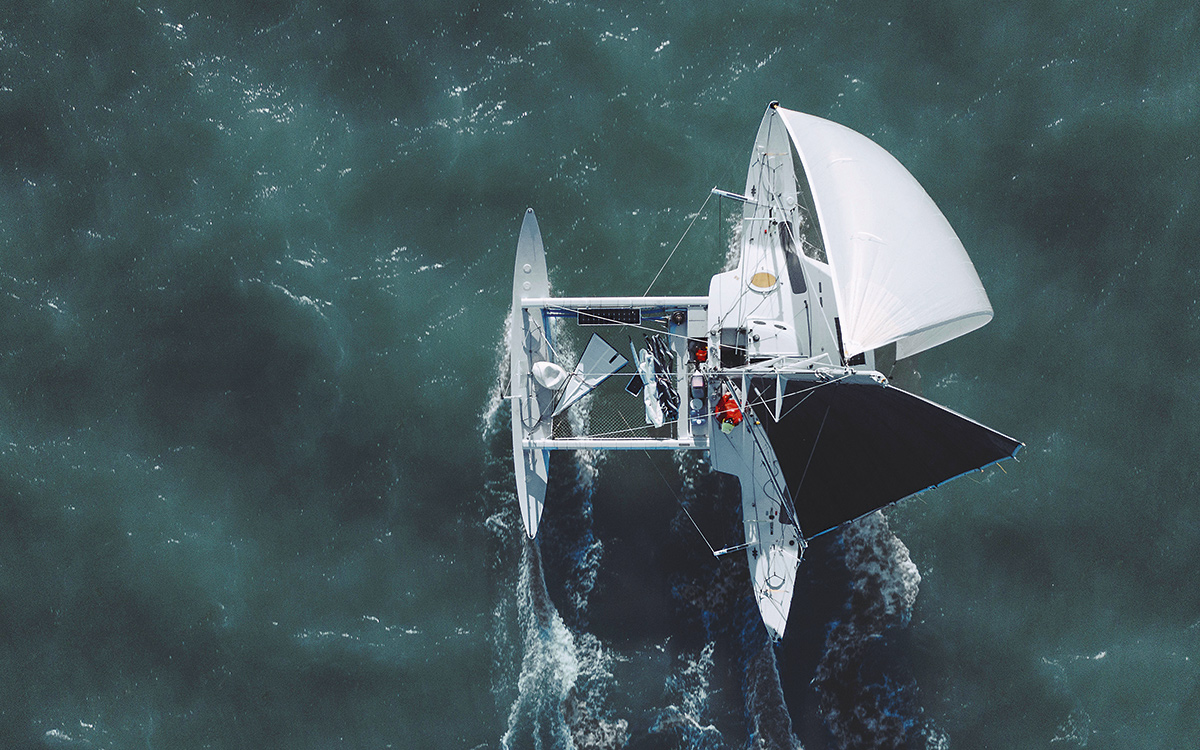
Jzerro: The oceangoing Pacific proa
The great Californian Gold Rush of the 1840s and 1850s saw over a quarter of a million people follow the…
This was my first canoe construction and the design was successful, though I came to understand what an old seadog I had met a long time ago in St Malo meant when he told me: “When it comes to boats, the best way to end up a millionaire is to start out as a billionaire!”
But what I gained by living this project was much more valuable than the money.
The next build was a larger Va’a Motu for the hotel, whose owner wanted a modern version of a traditional canoe for their beach club.

The single-seat Va’a Iti trimaran developed for a hotel in Bora Bora. Photo: Julien Girardot
This canoe was 20ft long, built of kauri wood using strip planking, while the rig was made from carbon windsurf masts. There is no rudder so the sailor helms in the traditional Polynesian way, with a paddle in the water.
A dream, Te Maru O Havaiki
Te Maru O Havaiki means ‘the shadow of Havaiki’ and is the realisation of a dream – or certainly of the fantasy that I had as a first-time visitor to the Pacific.
Now, I understand that for French Polynesian locals what is past is past. Here people think of the now, the present. The future and past are not so important; it’s another perception of life. They say of people in the islands: ‘They’ve got the time, and people from busy cities, they’ve got the clock.’

Making the two ‘iakos’, the linking spars that connect the ama to the main hull. Construction was complex due to their shape, with marine plywood, strip planking and hard foam core wrapped in composite. Photo: Julien Girardot
Te Maru O Havaiki is a 30ft Va’a Motu (outrigger canoe) designed by a local architect, Nicolas Gruet, and also built by Alexandre Genton.
The build created the opportunity to train two young people from Fakarava, and one of these young men, Toko, hung in right to the end of the construction. He proved to be an excellent laminator as well as disconcertingly natural at sailing the 30ft canoe, which is not an easy machine for a beginner to handle. The Paumotu people have an incredible ease with the water.

For the children, there was the tradition of the ‘titiraina’, a model of a sailing dugout they played with and raced; a fun game which also allowed them to understand the wind and the sea from a very young age. Photo: Julien Girardot
The project secured sponsorship from the French marine preservation agency, which gave us almost €40,000. They liked the local values and tradition, but the most interesting element for them was the scientific element of the project. For them we had to map an area of Fakarava’s lagoon using kites equipped with cameras!
For more than two months we sailed almost every day, skimming the lagoon from east to west and from north to south, sometimes camping rough for two or three nights to explore further.
During each outing we learned a little more, and gained confidence by sailing with the same crew.
We start to dare to sheet on a little more. The canoe is fast, but on one tack it is unstable. Whenever we tack, we shake out or put in a reef, it’s a delicate balancing act. Others, more courageous than us, sailed with just two people, and later were able to turn by gybing. Three crew is fine, but you have to reef… four is better, five is ideal.

Polynesian celebrations for Te Maru O Havaiki’s launch day. Photo: Julien Girardot
In the end, a government inspector from maritime affairs decided, after a stability test, not to register the dugout because it is too unstable. He is not a sailor, nor Polynesian, but freshly arrived from Dunkerque, where his job was to license cargo ships.
I don’t think he understood the importance of the shape of our canoe and it was painful at the time, but understandable with hindsight.
The dugout canoe in this configuration, with only one ama, will not be a 100% safe boat. Instead we will transform the canoe into a trimaran. The Va’a Motu association reconvened to re-elect a new board in April 2021. Now we will write a second chapter, but this time in a trimaran. Te Maru O Havaiki continues to tell the story of the evolution of multihulls.
If you enjoyed this….
Yachting World is the world’s leading magazine for bluewater cruisers and offshore sailors. Every month we have inspirational adventures and practical features to help you realise your sailing dreams. Build your knowledge with a subscription delivered to your door. See our latest offers and save at least 30% off the cover price.
- Skip to main content
- Skip to header right navigation
- Skip to site footer

Albom Adventures
Capturing the essence of travel through photography
Inspiring New Zealand travel through photography
Polynesian Outrigger Canoes Close Up: In the Museum and on the Water
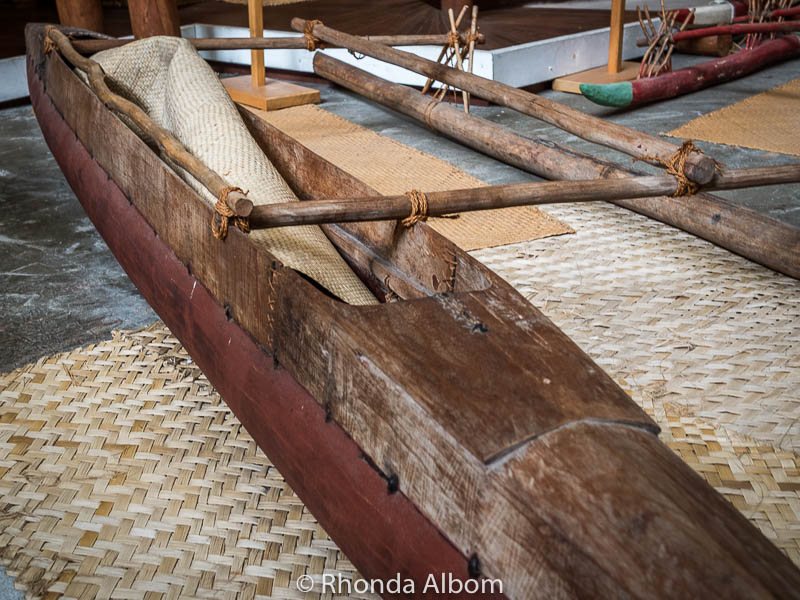
Long before the days of GPS and satellites, curious and brave seafaring explorers used their knowledge of the ocean and the night sky for guidance. They explored the oceans in Polynesian outrigger canoes, the style of which has sailed the Southern Pacific Ocean for over 5,000 years.
In some places, single wooden-hulled Polynesian outrigger canoes are still in use today.
While a single carved-out tree makes up the hull, what distinguishes Polynesian outrigger canoes is that traditionally, they have only one outrigger. In contrast, Southeast Asia more often had double outriggers. Importantly, double-hulled canoes (catamarans) were also popular amongst the early Polynesian people.
Today, many original style wooden vessels can be found on the waters, but more often we have seen Polynesian outrigger canoes made from modern materials. However, the basic long narrow shape with the addition of only a single outrigger has withstood the test of time.
It is the detailed handwork of the older vessels that I find so intriguing.
Taking a closer look at the construction details of the Polynesian outrigger canoes, the challenge these brave men faced seems multiplied.
The New Zealand Maritime Museum displays replicas of voyaging canoes from Polynesia, Melanesia, and Micronesia.
Larger vessels were used for migration sailing and were often double-hulled canoes. In fact, these are the type of boats that brought the first Polynesian people to New Zealand.
The legend of Kupe
Maori legend tells us that Kupe discovered New Zealand about 1,000 years ago. He sailed to Aotearoa (New Zealand) from Hawaiki, the traditional homeland of the Maori people. Today, no one today knows the exact location of Hawaiki. However, the accepted belief is that it is somewhere in Polynesia.
Where is Polynesia?
Polynesia is an eastern subgroup of Oceania and consists of over 1,000 islands in the Southern Pacific Ocean. It is not as clearly defined as many regions with land borders. In fact, different sources include different countries in Polynesia. The conflict is generally regarding the outliers.
However, regardless of where you draw the physical borders, most will agree that the countries listed just below are culturally Polynesian. A triangle from Hawaii to New Zealand to Easter Island defines this group.
The commonly agreed-upon list of countries of each region:
- Polynesia: American Samoa , Cook Island , Easter Island, French Polynesia , Hawaii , New Zealand , Norfolk Island, Niue, Pitcairn Islands, Rotuma, Samoa , Tokelau, Tonga, Tuvalu, Solomon Islands, and Wallis and Futuna.
- Melanesia: Fiji, New Caledonia, Papua New Guinea, Solomon Islands, and Vanuatu.
- Micronesia: includes the archipelagos of the Caroline Islands, the Gilbert Islands, the Mariana Islands, and the Marshall Islands. There are also independent islands in the region.
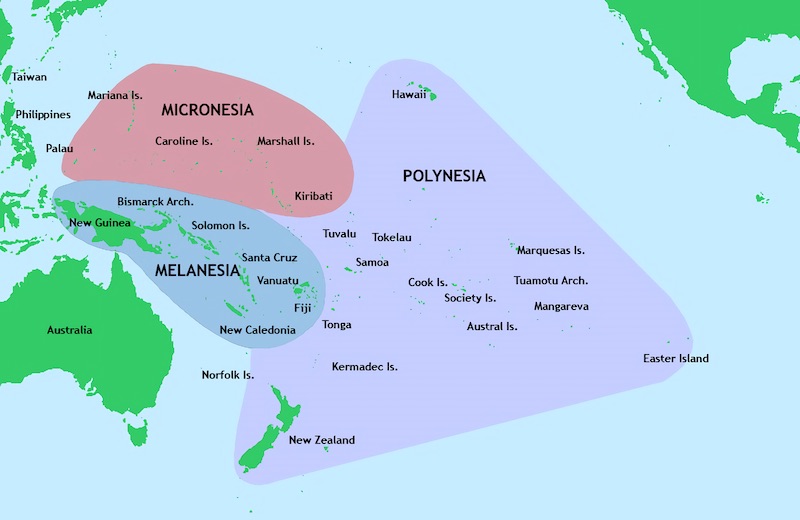
Polynesian outrigger canoes
What we do know is the detailed craftsmanship that went into building Polynesian outrigger canoes is similar throughout the region.
Many replicas of these boats are on display at the Maritime Museum in Auckland, and it’s a great place to get a closer look at some of the details.
At the top of this page is a classic example of an outrigger canoe. The main parts are:
- Hull/canoe – the hull that holds the canoe paddlers, carved from a single log, or stitched together.
- Boom: Rather than a single boom like modern sailing vessels, the sail is lashed to two separate booms to raise the sail.
- Sail: woven from plant materials and sewn together in strips. Pandanus matting is the most common in Polynesia. However, New Zealand used flax.
- Outrigger boom: spars leading out from the hull.
- Outrigger: the smaller lateral supports that float on the water and offer balance.
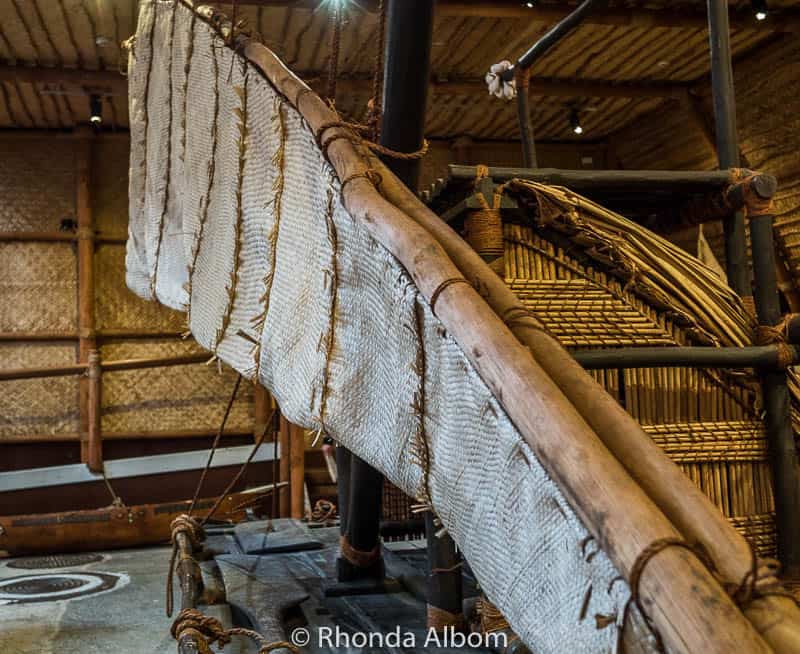
Polynesian outrigger canoes from Tonga
Just below is a Tongan Tongiaki, a double-hulled voyage canoe. The small hut offers the only protection the brave sailors had against the oceans. It’s similar in style to the boats that originally brought the Polynesian Maori to New Zealand. Although, the Maori migration boats are believed to have been about 20 meters in length.
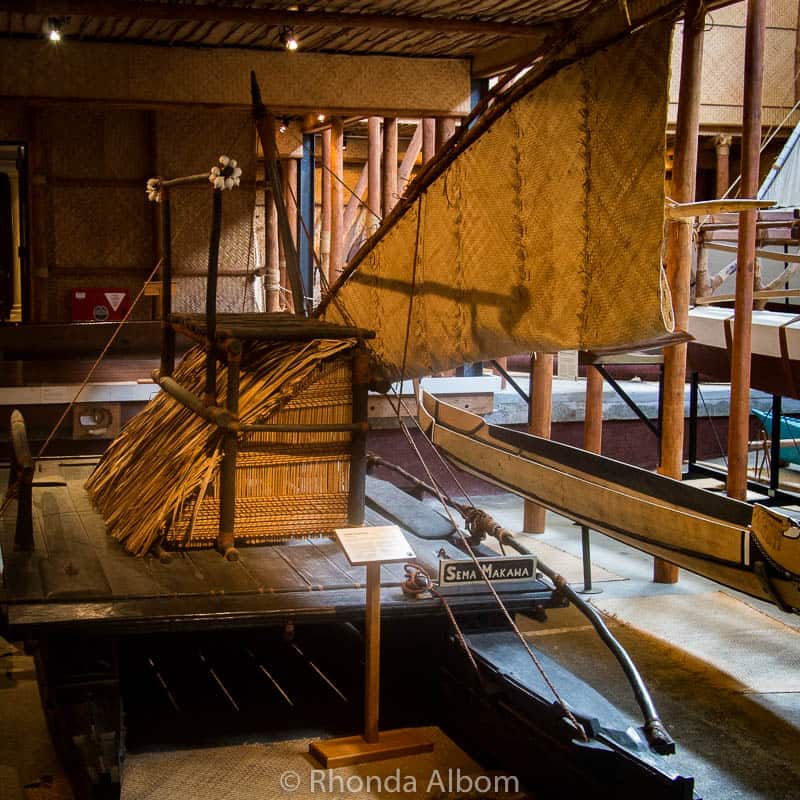
Polynesian outrigger canoes from New Caledonia
This vessel is from the Isle of Pines, an island in the archipelago of New Caledonia ( Melanesia ). It’s a mix of modern and traditional styles and base materials.
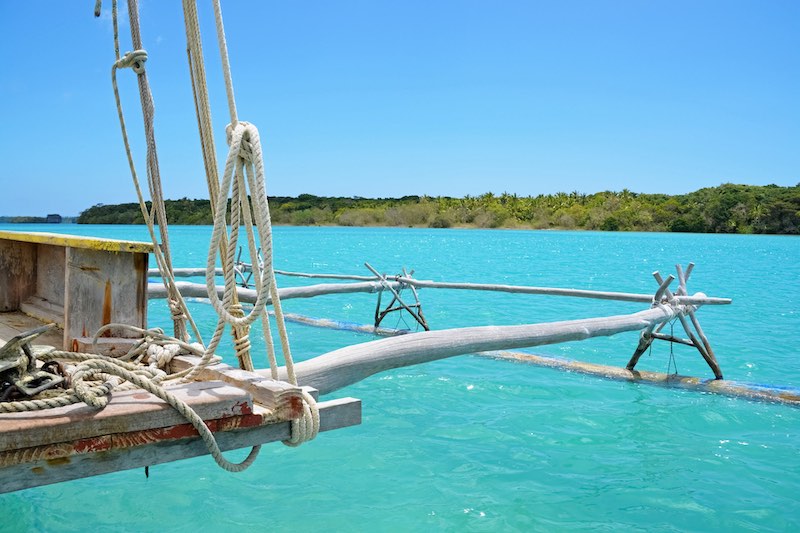
Polynesian outrigger canoes from Kiribati Atolls
Also at the museum is this Polynesian outrigger sailing canoe. In the background of the first shot below is the hull, outrigger boom and part of the sail of Taratai, a 76-foot baurua voyaging canoe from the Kiribati Atolls (Micronesia).
Check out the impressive detail in the lashings on both the smaller canoe and the larger migration vessel.
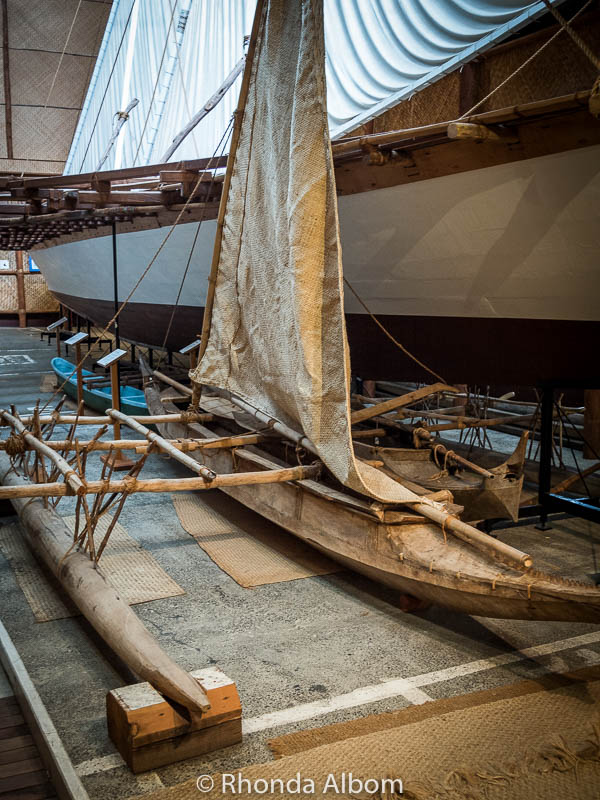
Polynesian outrigger canoes from the Cook Islands
We took all three of these shots on Rarotonga in the Cook Islands. The first two were modern racing vessels. The third is a historic waka outside the Cook Islands Museum and Library.
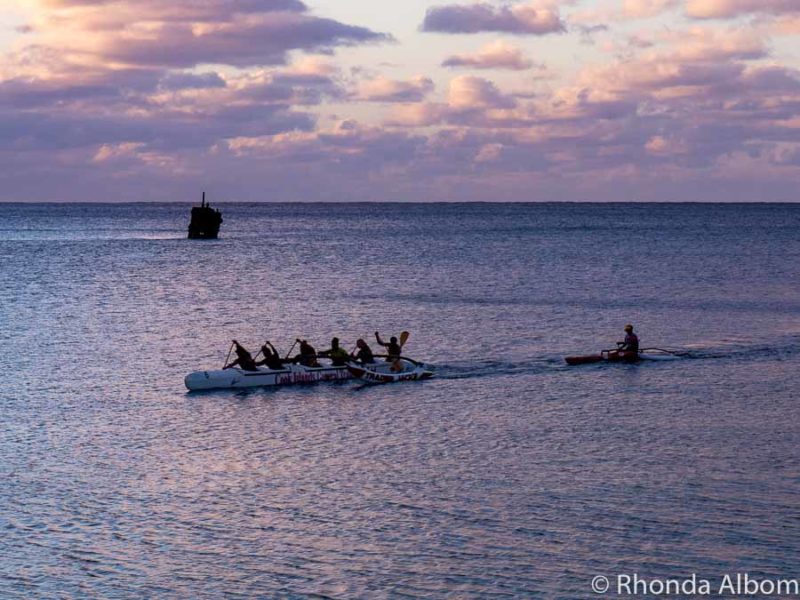
Canoes from French Polynesia
French Polynesia consists of over 100 islands stretching for more than 2,000km. The capital Papeete is located on the island of Tahiti , one of the better known of the islands.
We have visited a few of these islands but captured photos of Polynesian outrigger canoes only in Moorea.
Where to have your own outrigger experience
We are always on the lookout for new experiences that have great reviews from people who have tried them. Here are three that are now on our radar:
- Outrigger Canoe Surfing in Honolulu, Hawaii An exciting way for the entire family (ages 5+) to catch a wave, this adventure will have you surf three waves as you learn a bit about the history of what was once the official sport of the royal family. Considered so safe, life jackets are not required. Reserve your outrigger canoe surfing experience here.
- Outrigger Canoe Snorkel Tour in Maui, Hawaii Starting from Wailea Beach you will paddle down the south shore to a snorkel spot featuring sea turtles, a variety of fish, and coral that can easily be observed in the pristine waters. You will learn a bit about the culture and celestial navigation from your guide as you paddle to your snorkel spot. Reserve your outrigger canoe snorkel tour here .
- Combo Sunset Cruise & Romantic Dinner in Bora Bora, French Polynesia Not a traditional canoe, as this outrigger vessel is powered, but you will enjoy a two-hour romantic cruise, a glass of champagne, and the sunset along with not more than five other couples. Then you will be taken to the renowned St James Restaurant, where you will have a private romantic dinner at a pre-reserved table. Reserve your cruise and dinner here .
More wooden canoes at the New Zealand Maritime Museum
Documenting New Zealand’s nautical history, the maritime museum in Auckland takes us through the arrival of the nation’s early population. Here are two more images of single-hulled canoes without outriggers.
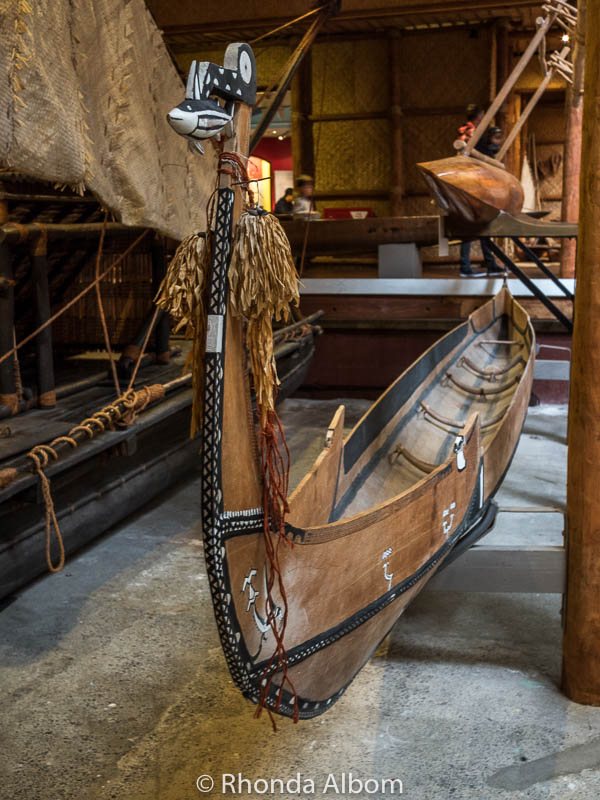
Practical information and tips for visiting the museum in Auckland
- The museum is at Auckland’s Viaduct Harbour at the corner of Quay and Hobson Streets.
- The museum is open nearly every day from 10 am – 5 pm. Also available are optional sailings on the Ted Ashby most days, which offer a chance to get out on the water on a ketch-rigged deck scow. Reserve your museum entry tickets here .
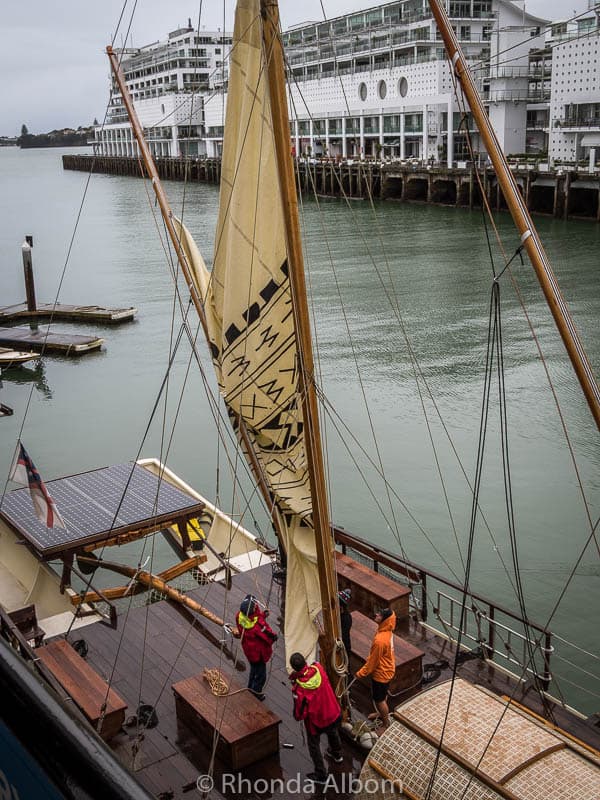
Save on your trip with these resources
These are our go-to companies when we travel. We believe this list to be the best in each category. You can’t go wrong using them on your trip too.
- Flights : we use Expedia for the best and cheapest flight options.
- Accommodations: we use Booking.com (hotels), VRBO (self-contained), or Hostelworld (budget).
- Cars (gas or electric): we use RentalCars to search for deals and dealer ratings.
- Motorcycles : we have heard good things about BikesBooking .
- Campervans or Motorhomes : we use Campstar where Albom Adventures readers get a 3% discount.
- Private guides : we often find the best option is to work with a private guide .
- Travel Insurance: while not required, we always opt for travel insurance and start at InsureMyTrip to compare coverage plans.
Check out our travel resources page for more companies that we use when you travel.
Save for later
If you enjoyed taking a closer look at these Polynesian outrigger canoes, please share this pin on Pinterest:
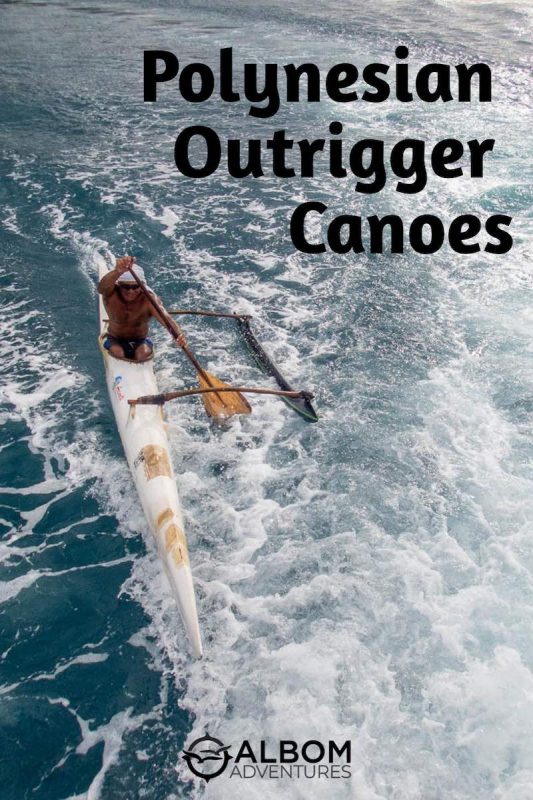
Can you imagine crossing the oceans on one of these Polynesian outrigger canoes?
Other islands you might like to see:
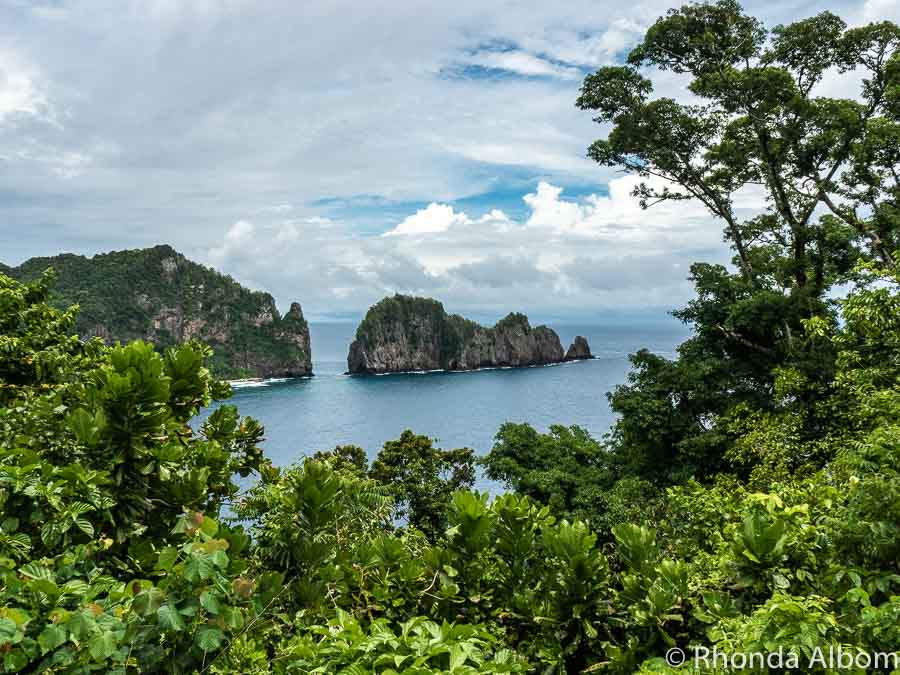
Visiting American Samoa: Home to a Tropical US National Park
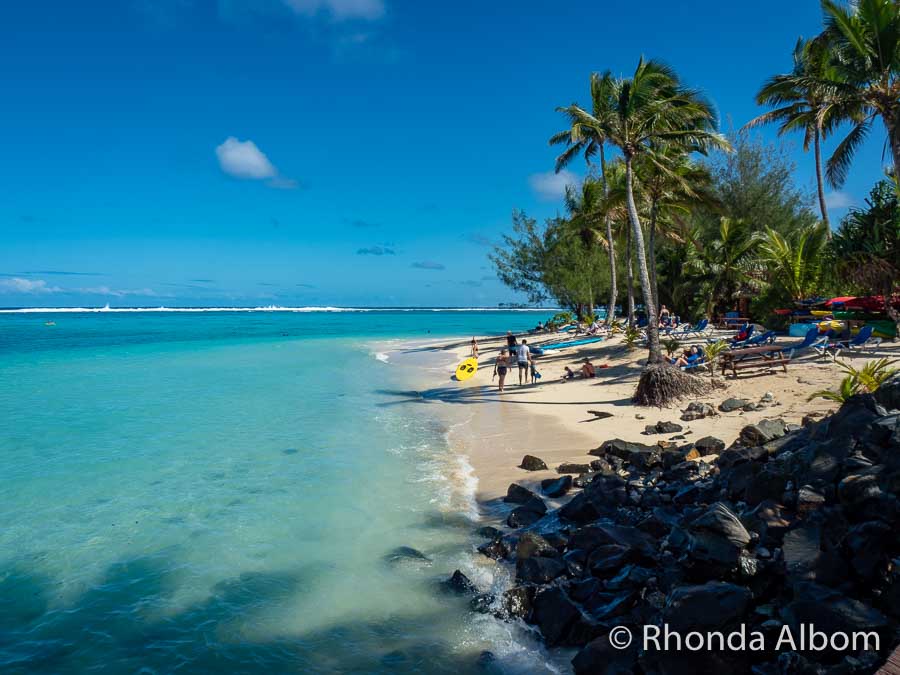
26 Things to Do in Rarotonga: White Sand Beaches, Culture, or Adventure

Best Things to Do in Koh Samui, Thailand – Paradise in a Day
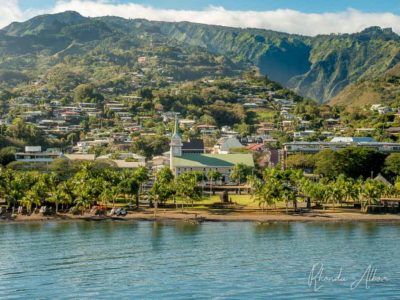
Things to do in Tahiti: Relax and Explore in French Polynesia
For more tips … join Explore New Zealand, the country’s largest NZ travel and photography group on Facebook (free).
About Rhonda Albom
Capturing the essence of travel through photography, Rhonda Albom is the primary author and photographer at Albom Adventures. She is an American expat based in New Zealand. She travels the world with her husband.
Reader Interactions
Glenda Cates
August 3, 2017 at 12:39 am
Lovely and makes me wish I had a boat to take my son out in. Have a great day.
Rhonda Albom
August 4, 2017 at 10:45 pm
A boat like one of these, or something a bit more modern?
August 2, 2017 at 6:31 pm
this is one of my favourite museums because of the details.
Sandy N Vyjay
August 2, 2017 at 2:36 pm
The word Polynesia itself evokes images of exotic beaches and islands for me. The history of New Zealand and how it was discovered is fascinating. The Maritime museum sounds really interesting, a window to the past. The canoes look ingenious and a silent tribute to the skills of the Maoris of yore.
August 2, 2017 at 6:36 pm
I agree, when I hear the word I think of exotic destinations, palm trees, and white sand beaches. The maritime museum is the perfect place to learn about the history and how the cultures intermix.
Siddhartha Joshi
August 1, 2017 at 4:09 am
Excellent post and really enjoyed looking the history of NZ through it’s original inhabitants! Great pictures of the boat too…gorgeous stuff!
July 31, 2017 at 8:52 pm
What an interesting cultural post. I like that they pass down their skills from generation to generation. Thank you for more knowledge.
July 31, 2017 at 11:29 pm
I am always impressed with skills like this that are passed down for hundreds of years.
July 31, 2017 at 4:37 pm
Very interesting post. The craftsmanship of these outriggers are incredible, the pictures definitely brought me there at the museum to appreciate this.
I hope you get a chance to visit live, it’s a wonderful museum.
July 31, 2017 at 2:38 pm
I can’t even imagine making one of these! What craftsmanship. It’s an amazing art!
July 31, 2017 at 11:25 pm
I could imagine making one, but I couldn’t image sailing one.
July 31, 2017 at 9:05 am
How beautiful is that outrigger? I studied anthropology in college, so I know that I would love this museum. It’s so amazing to see how amazingly they used their materials to travel so far. It’s so fascinating!
July 31, 2017 at 11:16 pm
The museum moves through the ancient history really quickly. The rest focuses mostly on the last 150 years.
July 31, 2017 at 12:05 am
What an unusual museum. It looks pretty fascinating
July 31, 2017 at 11:08 pm
It takes visitors through New Zealand’s maritime history.
Megan Jerrard
July 30, 2017 at 6:27 pm
This is quite incredible, I imagine the Polynesian outrigger canoes would have been quite cutting edge technology for their day. It’s quite fascinating to imagine a world of exploration and discovering new lands before we had electronics and motors and all the wonders of knowledge of the modern day. I was really drawn in by the story of Kon Tiki, where Thor Heyerdahl lead an expedition in 1947 across the Pacific Ocean from South America by traditional Polynesian raft. Obviously doesn’t have much to do with New Zealand, but your photos reminded me of that 🙂 Incredible that they crossed oceans in these isn’t it!
July 31, 2017 at 11:01 pm
The boats are pretty impressive for their age, and the balance must be quite incredible for them to sail so far.
Niels Thomas
July 30, 2017 at 5:52 pm
Very interesting read, but also my compliments for your excellent photography skills. Really makes the article stand out. 🙂
July 29, 2017 at 12:02 pm
They are quiet impressive.
July 29, 2017 at 1:23 am
That’s incredible!!
July 29, 2017 at 12:03 pm
They are quite impressive.
Paul F. Pietrangelo
July 28, 2017 at 2:45 am
This was a very interesting blog Rhonda. The binding was different and amazing. I really liked the canoe. How were these Polynesian outrigger made? Did the Polynesian people have materials to create canoe and outriggers? I would like to go on these Polynesian outriggers and see what it likes in the water. Interesting!
Have a great day Rhonda. See ya.
Cruisin Paul
July 29, 2017 at 12:01 pm
These boats are 100% hand carved and tied, from natural ingredients like trees and vines. I wouldn’t want to sail on one for very long. I prefer a bit of luxury.
Mindi Hirsch
July 27, 2017 at 6:45 pm
The Auckland Maritime Museum looks fascinating. In a way, it reminds me of the maritime museum in Palamos (Costa Brava) since both museums provide glimpses into the maritime past.
July 29, 2017 at 11:58 am
How small world. We did a long term home exchanged and lived in Palamos. The two museums are somewhat similar, yet quite different as Palamos seemed to focus on fishing and commercial industry.
July 27, 2017 at 8:31 am
I love reading post like this. I love anything historic really. These canoes are too cool. Hopefully I’ll make it to the museum one day!
July 27, 2017 at 9:13 am
Thnaks Shannon, I love learning about things like this, and really focusing in on the details.
Cindy Ladage
July 26, 2017 at 11:29 pm
I love the story of the canoes and especially the fact that after viewing you can go out and sail in a version of what you just learned about. Awesome!
July 27, 2017 at 9:12 am
The modern waka that you can sail on is quite a bit different as it is required to have all the modern safety standards in place.
Patrick Weseman
July 26, 2017 at 3:15 pm
Wow, what a cool place to visit. Your photos are amazing. I would so love to cool there.
Joyce Lansky
July 26, 2017 at 11:20 am
Wonderful post. As much as I want to voyage to New Zealand, I don’t want to go by boat. 🙂
July 26, 2017 at 6:12 pm
LOL – certainly not one of these boats. There is some modern luxury that would be nice to sail across the oceans.
Alissa Apel
July 26, 2017 at 7:44 am
The details are so artistic. I couldn’t imagine going through all the work involved in making one. I strongly appreciate it.
July 26, 2017 at 6:11 pm
There are still boat makers. When we were in Oman, we saw some of the boat builders who work in teams for five years to hand build a dow boat.
L. Diane Wolfe
July 26, 2017 at 5:50 am
So simple and yet so beautiful!
July 26, 2017 at 6:09 pm
And graceful if you see them sail.
July 26, 2017 at 1:14 am
Fascinating story of ancient migration and cool boats! The child in me always wanted to run away to a tropical island. The practical adult drove to Florida but it’s not really polynesia!
LOL – New Zealand is NOT tropical. We are subtropical. It is winter now, and about 50F right now. Parts of the island even get snow.
indah nuria savitri
July 26, 2017 at 12:14 am
Love all the details, Rhonda..such an incredible collections!
July 26, 2017 at 5:45 pm
I love the details too. Amazing craftsmanship.
July 25, 2017 at 11:20 pm
To my eye, it appears that these would be easy to tip over. I bet they’re sturdier than they look to me, though. Interesting shots!
July 26, 2017 at 5:38 pm
The distance between the hull and the outrigger determines stability: Closer is less stable. Further is more stable.
Hilary Melton-Butcher
July 25, 2017 at 9:20 pm
Hi Rhonda – what a stunning and fascinating museum to be able to look round – and yes ‘how did they do it’ … except we know they managed to use the winds to traverse the oceans … Love the craftsmanship … and it’s wonderful we can re-create the things our ancestors used – to enable us to realise a little more about early life … cheers Hilary
July 26, 2017 at 4:04 pm
They passed the skill down from father to son, using wind, stars, moon, birds and whale migration patterns. They could identify about 150 stars, and used them to find their way. I took a celestial navigation course once, but I was completely lost.
Teresa Kindred
July 25, 2017 at 1:54 pm
I love these! They look so big!
July 25, 2017 at 3:35 pm
I guess I should have put some people in them for perspective. Standing there and thinking about people being on them for months at a time, they looked really small.
Carol L McKenna ~ A Shutterbug Explores
July 25, 2017 at 11:01 am
Fascinating post and great photos ~ looks like a lovely area to visit ~ ^_^
stevebethere
July 25, 2017 at 10:13 am
Nice captures Rhonda interesting and clever 🙂
Have a tanfastical day 🙂
Photo Cache
July 25, 2017 at 10:09 am
What a very interesting cultural post. The photos are wonderful too.
July 25, 2017 at 3:34 pm
It was an interesting way to look at the exhibits I have seen so many times before.
July 25, 2017 at 9:56 am
Great shots of the craftsmanship. I would love to see these for real.
Have a fabulous day. ☺
July 25, 2017 at 3:33 pm
I knew you, my boatie friend, would love these images. If you ever come to New Zealand it will be the first place we take you.
Leave a Reply Cancel reply
Your email address will not be published. Required fields are marked *
Save my name, email, and website in this browser for the next time I comment.
Privacy Overview
| Cookie | Duration | Description |
|---|---|---|
| cookielawinfo-checbox-analytics | 11 months | This cookie is set by GDPR Cookie Consent plugin. The cookie is used to store the user consent for the cookies in the category "Analytics". |
| cookielawinfo-checbox-functional | 11 months | The cookie is set by GDPR cookie consent to record the user consent for the cookies in the category "Functional". |
| cookielawinfo-checbox-others | 11 months | This cookie is set by GDPR Cookie Consent plugin. The cookie is used to store the user consent for the cookies in the category "Other. |
| cookielawinfo-checkbox-necessary | 11 months | This cookie is set by GDPR Cookie Consent plugin. The cookies is used to store the user consent for the cookies in the category "Necessary". |
| cookielawinfo-checkbox-performance | 11 months | This cookie is set by GDPR Cookie Consent plugin. The cookie is used to store the user consent for the cookies in the category "Performance". |
| viewed_cookie_policy | 11 months | The cookie is set by the GDPR Cookie Consent plugin and is used to store whether or not user has consented to the use of cookies. It does not store any personal data. |

James Wharram Designs
Search Our Site
About james wharram designs.
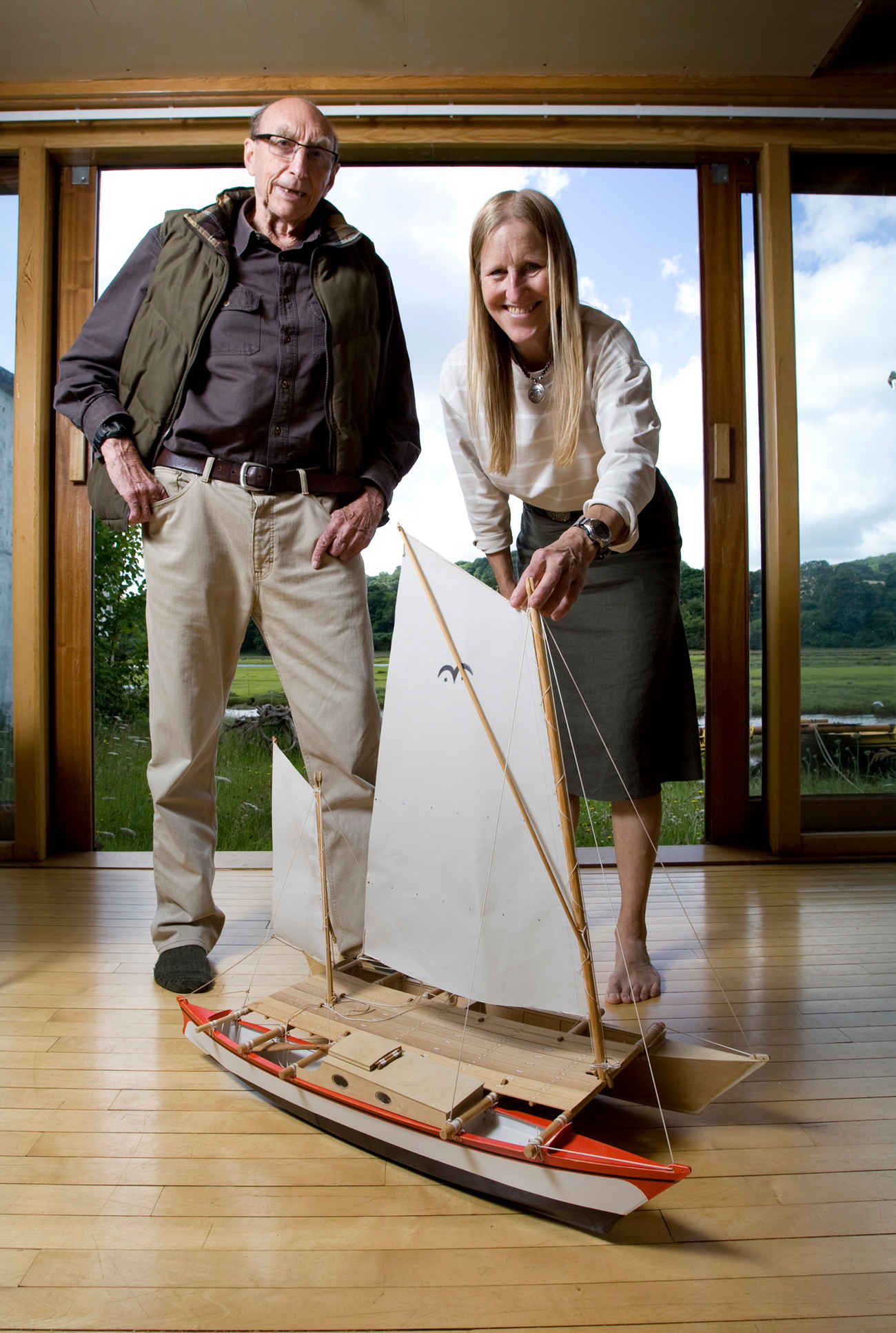
Who Are We?
James Wharram Designs are designers of unique double-canoe style sailing catamarans inspired by the canoe craft of the Pacific. They have their headquarters on the shore of Restronguet creek in Devoran, Cornwall.
James Wharram was the pioneer of offshore multihulls, making his first Atlantic crossing by catamaran in 1956 and the first ever North Atlantic West-to-East crossing by multihull in 1959. He started designing for self-builders in 1965. In 1973 Hanneke Boon joined him and became his co-designer.
Wharram designs are based on years of practical, hands-on experience of building and sailing ocean-going catamarans.
Wharram designs are renowned for their seaworthiness , stability and safe simplicity . Ask any ocean sailor and they will have seen Wharram catamarans in far off ports of call.
Designs from 14’ – 63’ are available for self-building in ply/epoxy with very detailed, easy to follow Plans often described as 'a course in boatbuilding'.
Several franchised yards offer professionally built Wharrams .
To find more about what Wharram Designs has to offer, explore our website. If you want to build your own catamaran and experience the freedom of sailing, your dream begins here.
Hanneke Boon
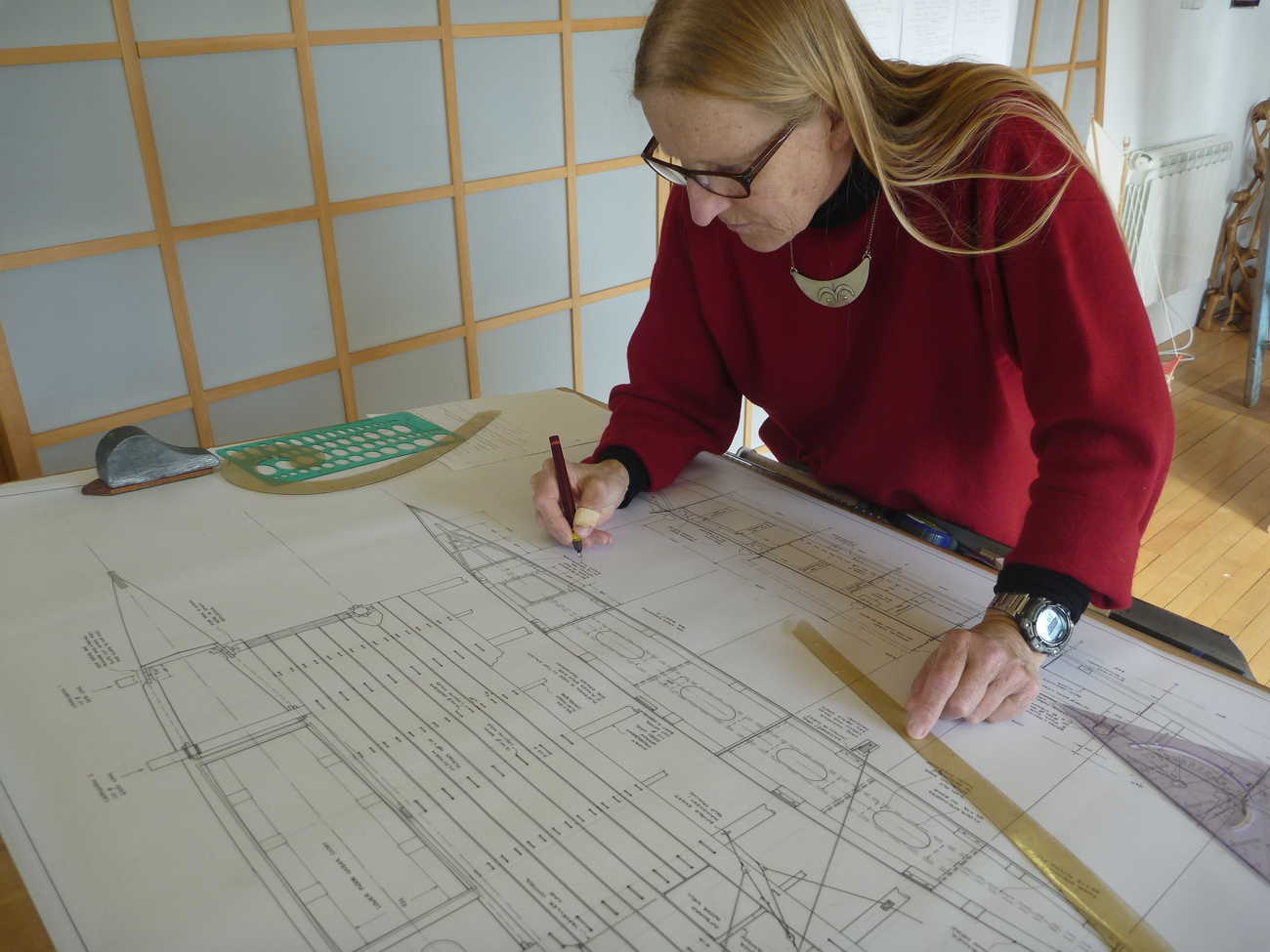
Hanneke Boon is head of James Wharram Designs , a role she has carried out for more than ten years, whilst supporting James Wharram in his advancing years.
Born in the Netherlands, Hanneke grew up in a sailing family. She was building and sailing Polynesian Catamarans at the age of fourteen and joined the James Wharram team at the age of 20. Being a very gifted artist / graphic designer / craftworker, she became James Wharram's co-designer.
Hanneke's all-round art abilities and practical boatbuilding experience have produced some of the clearest boat building instruction plans ever produced. She has drawn the majority of the Wharram Boatbuilding Plans since the 1970s.
Hanneke made two Atlantic catamaran crossings on Tehini when she first joined the team. Since then she has sailed thousands of ocean miles, including sailing round the world on Spirit of Gaia (1994-98), a voyage to Iceland (1999) and the 4000Nm Lapita Voyage (2008-09), when she skippered 'Lapita Anuta'. In 2022 she again crossed the Atlantic as crew on Pahi 65 'Largyalo' and is now the captain of 'Spirit of Gaia', sailing her in the Mediterranean.
She has built, or taken part in building more than sixteen Wharram designs, including developing many prototypes and the 63ft Spirit of Gaia. She is an expert in working with epoxy and has made instructional videos of her boatbuilding. From 2012 – 2016 she fully restored the 20 year old Spirit of Gaia with the help of volunteers.
She now sails when she can escape the drawing board or the computer. Hanneke loves experimenting with sail-rigs and shared James' deep interest in Marine Archaeology and the origins of Canoeform watercraft.
The following video is of Hanneke giving a 'Pecha Kucha' style presentation in Amsterdam on the subject of 'Integrating Philosophy with Boat design'. This very short presentation sums up Hanneke's history from a sailing childhood to becoming a boat builder, designer and ocean sailor. Throughout the theme is 'simplicity' as the philosophy behind the designs of James and Hanneke.
At the end of James' life she helped him finish his autobiography ' People of the Sea ' (published in 2020), which tells the full story of their lives.
BBC Radio Cornwall Interview - July 2023
More about hanneke:.
Hanneke's realised vision to build 2 Tikopian double canoes and give them to the islands of Tikopia and Anuta, so they can continue to be self-sufficient and take pride in their ancient sailing heritage. The two canoes would then be sailed the 3000 miles to Tikopia along the ancient Polynesian migration route for handing over to the islanders.
An illustrated 6 minute poem of Hanneke, from a young girl sailing with her father, ending up as a boatbuilder, ocean sailor and designer.
Hanneke headed a varying team of helpers that have made an annual visit to Greece since 2012 to carry out maintenance work. She has written detailed blogs that cover this work in detail and we hope they may be useful to you in carrying out your own project.
The fully story of Hanneke's life of sailing and designing with James.
James Wharram

James Wharram (1928-2021) designed his first offshore cruising double-canoe/catamaran, the 23' 6" TANGAROA in 1953, before the word catamaran was yet in common use and began sailing with her off the coast of Britain with two German girls, Ruth Merseburger (Wharram) and Jutta Schultze-Rohnhof. He was inspired to do this by Frenchman Eric de Bisschop , who sailed a double canoe from Hawaii to France in 1939. James believed in the innate seagoing qualities of the double canoe and set out to prove them with two pioneering Trans Atlantic voyages on TANGAROA (1956) and 40ft RONGO (1959). He wrote an account of these first pioneering years in Two Girls Two Catamarans .
Since then, James Wharram, has been designing, building and sailing offshore catamarans longer than any other multihull designer . Already in 1987 the 'Multihulls Buyers Guide' showed that James Wharram Designs had sold three times more plans than any other multihull designer in the world. Design sales have since topped 10,000.
One reason for this success is that James Wharram was a 'hands-on' designer having, over his lifetime, built personally many of the prototype designs. These prototypes were built in the open, in barns, workshops and all the range of building sites available to self-builders, in a variety of climate types from northern European to the Tropics.
Because James and his co-designer Hanneke Boon preferred sailing to building, they have always endeavoured to refine their Construction methods to their simplest form, following the famous Bauhaus motto "Less is More". The advent of epoxy in boatbuilding in 1980, combined with a Wharram and Boon evolved 'Stitch & Glue' building method, opened up new ways of achieving this aim.
Together with Hanneke he developed many new Appropriate Technology building methods. Of special note here are the lashed crossbeam connections and the Wharram Wingsail Rig .
Throughout his life, James has been interested in the history of Watercraft, particularly the origins of the Canoeform craft of the Pacific. He has written papers on this subject and lectured at Marine Archaeological conferences. He was made a 'Fellow of the Royal Geographical Society' for his pioneering work in this field.
In 2008, his career came full circle, when at the age of eighty, 50 years after his pioneering voyages, he sailed the arduous Lapita Voyage , the ancient migration route into the Pacific, on the Tama Moana design 'Lapita Anuta' skippered by Hanneke Boon.
In his final years he focussed his energies with Hanneke's help on finishing his autobiography ' People of the Sea '.
The charismatic James was often referred to as a 'Living Legend' or as written in 'Yachting Monthly' in January 2006: "James Wharram is considered by many to be the father of modern multihull cruising."
James Wharram passed away on 14th December 2021. However, this is not the end. Hanneke and all the Wharram World will keep his work alive.
More about James:
People of the Sea is the life story of iconic catamaran designer James Wharram, from a Wartime childhood in Manchester, to mountaineer, to pioneer catamaran sailor in the 1950s, to designer of modern Polynesian catamarans.
Written by James Wharram. A tale of adventure in the fifties, when James Wharram and two German girls, Ruth and Jutta, sailed from Falmouth and across the Atlantic in their homemade catamaran Tangaroa. The story of their stormy crossing of the Bay of Biscay, their winter in northern Spain living off the proceeds of magazine articles, and the dangers encountered in their unusually rough trade wind passage to Trinidad.
Philosophical writings by James, papers delivered at major marine archeology conferences, and biographies.
On the 14th December James Wharram left this earthly world, joining Ruth, Jutta and his many close friends that departed before him. At 93 years old his spirit has set out on the voyage to sail the oceans of heaven.
This eulogy was delivered by Matt Knight at James Wharram's funeral service, which took place at 3:00pm on Thursday 30th December at Truro Crematorium.
In the summer of 2022, we held a special Hui in celebration of James’ life. A fleet of Wharram catamarans and other boats joined us.
Ruth Wharram
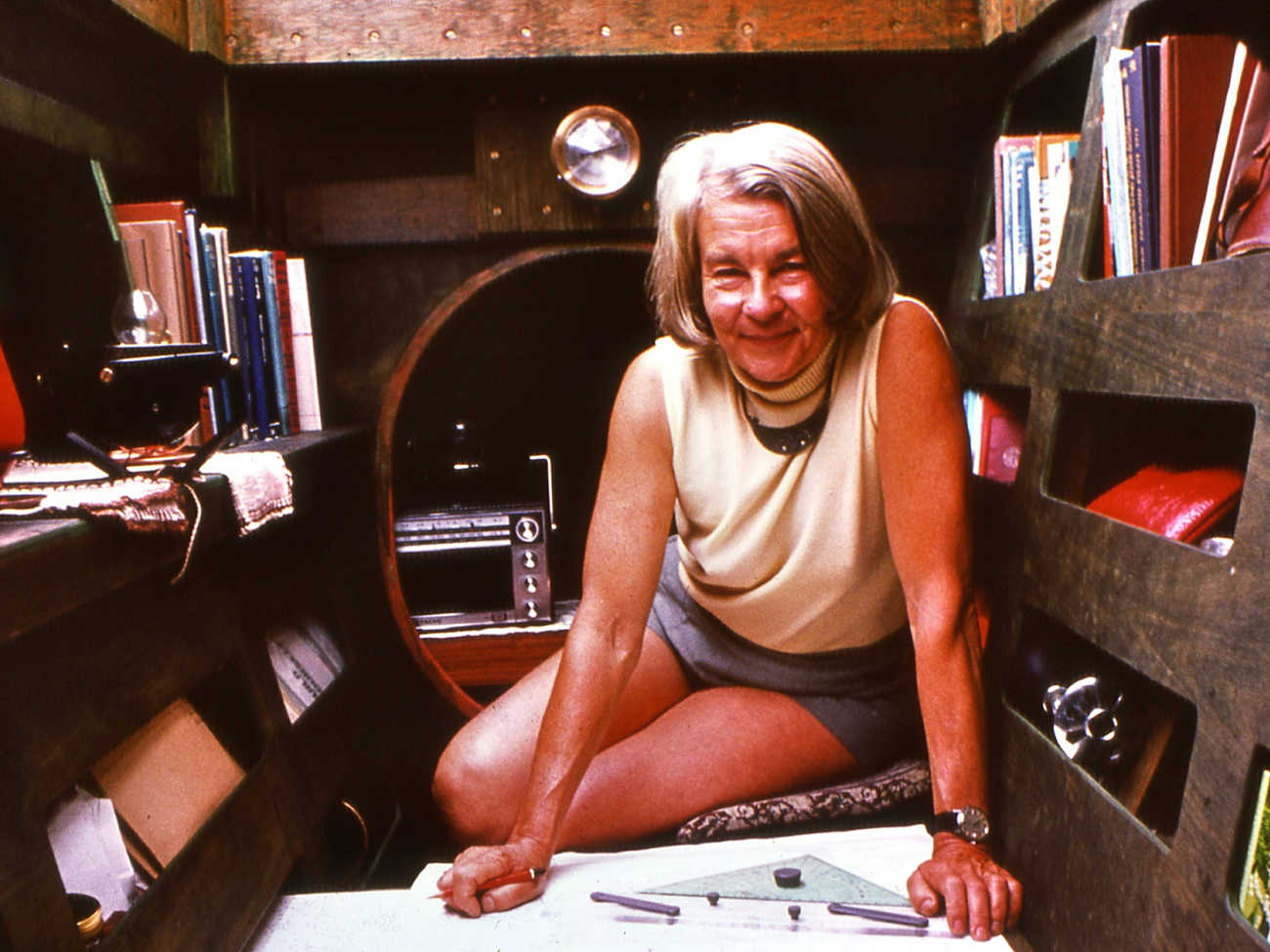
German born Ruth Merseburger (1921-2013) was James' other lifelong partner and shared James Wharram's early pioneering voyages. Ruth was one of the first people to believe James in the early 1950's when he said that the ancient double-canoe of the Polynesians would be the yacht of the future. With her practical determination she has been the driving force behind James in his many projects .
A first class navigator (in the days before GPS) she made seven Atlantic crossings, endured a severe gale crossing the Tasman Sea, sailed half way round the world on 63ft 'Spirit of Gaia' and made innumerable coastal voyages on Wharram catamarans. She was always in demand to be crew/navigator on all types of sailing yachts.
Her sailing adventures started in the early 1950s and continued throughout her life. Alongside this she drafted some of the plans of the early Classic Designs and managed the Wharram sales office for over 40 years, communicating with the hundreds of builders. In her late 80s she retired as office manager but kept in communication with her many sailing friends by email and followed James and Hanneke's sailing adventures on the internet.
Ruth has been a writer, photographer and film maker. She shot all the footage for the Building and Sailing of Tehini film on a hand-wound 16mm Bolex. She had many articles of her sailing experiences published and in 2008 assembled her writings in a Special Collection .
Ruth passed away on September 4th 2013 leaving a big gap in the James Wharram Designs team.
More about Ruth:
Two vintage movies filmed by Ruth Wharram in the early days of Wharram Catamaran designs. Tehini was one of the largest catamarans of her time and was built in less than 2 years with mainly hand tools. Her first voyages were to North Spain and Holland, during which time she met many other Wharram Catamarans. Free to watch online.
A wonderful collection of articles, stories and diaries by Ruth Wharram.
Ruth Wharram (nee Merseburger) has departed this life in the early morning of 4th September, at the age of 92, at home in Devoran.
- Boatbuilding
- Hanne's story
- Don's story
- Kevin's story
Hawaiian Canoe Sailing Tours
Sail a traditional Hawaiian canoe on Hilo Bay in the moonlight, experience the pristine beaches and rugged cliffs on the Kona coast, hike along the shore on a path in the lava where the Hawaiians have walked for centuries, explore steam vents and black sand beaches.
Wa'akaulua is the Hawaiian word for double hull canoe. Captain Kiko is a sailor and experienced boat builder specializing in traditional Hawaiian canoes made by hand. He has spent his entire life on the Big Island of Hawaii and can show you many off-the-beaten-path places on this island. On his tours he will teach you about the history, geology and customs of this land and the sea surrounding it. He will teach you to paddle a traditional Hawaiian canoe. He might even teach you a few Hawaiian words and songs.
Come experience Hawaii with Captain Kiko. It will be the highlight of your Hawaiian vacation.
All trips run from the mouth of the Wailoa River in Hilo, Hawaii.
Call captain kiko at (808) 895-3743..
copyright © 2019 by Kiko Johnston-Kitazawa
June 13, 2017
Fantastic Voyage: Polynesian Seafaring Canoe Completes Its Globe-Circling Journey
The Hōkūleʻa vessel is set to finish its first circumnavigation later this week in Honolulu
By Richard Schiffman
On June 17, a 62-foot-long double-hulled canoe is slated to arrive in Honolulu, completing the first-ever round-the-world voyage by a traditional Polynesian vessel—a predecessor of the modern catamaran.
The trip began in May 2014 when the Hōkūle ʻ a (Hawaiian for Arcturus, a guiding zenith star for seafarers) sailed westward from Hilo on Hawaii’s Big Island. Since then it has plied five oceans, visited 19 countries and traversed more than 40,000 nautical miles.
Nainoa Thompson, president of the Polynesian Voyaging Society, which organized the expedition, has called oceangoing vessels like the Hōkūle ʻ a “the spaceships of our ancestors,” adding, “If you took all of the genius that has allowed us to put a man on the moon and applied it to an understanding of the ocean, what you would get is Polynesia.”
On supporting science journalism
If you're enjoying this article, consider supporting our award-winning journalism by subscribing . By purchasing a subscription you are helping to ensure the future of impactful stories about the discoveries and ideas shaping our world today.
The round-the-world journey was planned in part to celebrate Polynesia’s seafaring achievements in developing and using a unique form of traditional navigation. During an era when most Western sailors still feared to leave sight of shore because they had not yet developed a way of determining longitude, Pacific islanders were already routinely crisscrossing a region spanning 25 million square kilometers—an oceanic world covering nearly one quarter of Earth’s surface—according to Wade Davis, an Explorer-in-Residence at the National Geographic Society and author of The Wayfinders: Why Ancient Wisdom Matters in the Modern World .
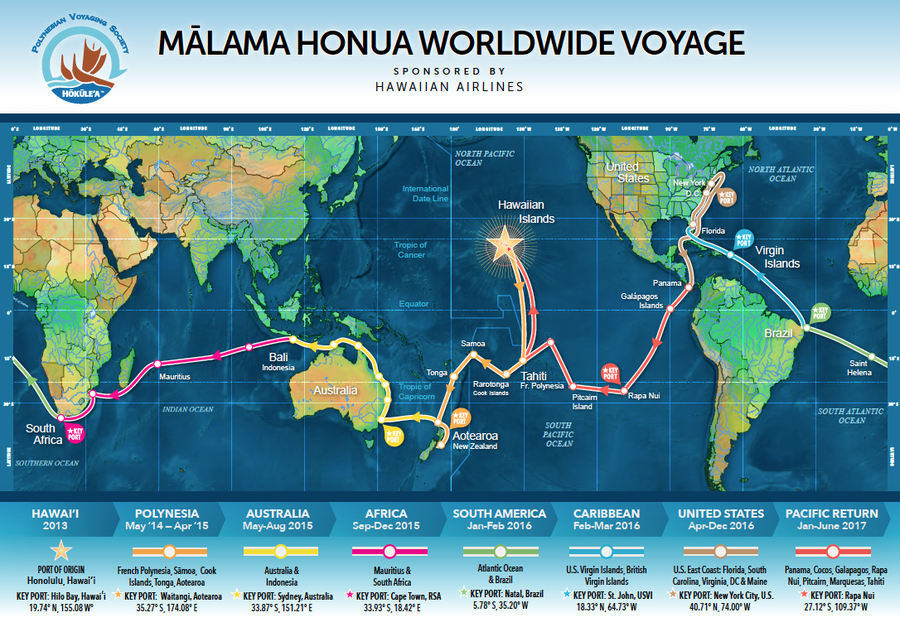
Voyage Map of Hōkūle‘a. Credit: Polynesian Voyaging Society
For much of the 20th century, anthropologists assumed the thousands of far-flung islands of the Pacific were settled after being accidentally found by sailors who were driven off course by storms. But native Polynesians have long argued, based on their oral traditions and nautical lore, that settlement was the result of deliberate journeys of exploration and colonization undertaken by highly skilled navigators. “For centuries, Europeans stubbornly refused to acknowledge Polynesian achievements because they simply could not believe that a so-called primitive society was demonstrably better at navigation than they were,” Davis says.
Thompson was trained in the vanishing Pacific art of “wayfinding” by Mau Piailug of Micronesia—one of the last of the traditionally schooled navigators—who died in 2010. Following Piailug’s instructions, the Hōkūle ʻ a has been guided entirely without modern navigational aids such as nautical charts, compasses and GPS, instead relying on observation of the position of celestial bodies, the direction of waves and the movement of seabirds to set its course. To accurately maintain their bearing at night, the Hōkūle ʻ a navigators had to memorize the nightly courses of more than 200 stars, along with their precise rising and setting locations on the horizon.
Although ancient in design, the Hōkūle ʻ a was constructed in part from modern materials including plywood, which has replaced the scarce seasoned Hawaiian koa wood that would have framed the hulls of ancestral craft. The craft also has Dacron sails instead of ones woven from traditional lauhala leaves. The 17-member rotating crew, whose members each served monthlong stints, supplemented their packaged foods and water with fish they caught during the voyage and rainwater.
The current circumnavigation is the latest and most ambitious of a series of interisland journeys that have taken place since the Hōkūle ʻ a was first launched in 1975. Transoceanic voyages like the present one are believed to have largely ended in Polynesia with European contact more than four centuries ago, and many Polynesians credit the current revival of long-distance canoe voyages with having initiated a cultural renaissance.
Anthropologists have long debated how the Pacific islands—separated by thousands of miles of open ocean—were first settled. In 1947 Norwegian adventurer Thor Heyerdahl sailed the balsa wood raft Kon-Tiki from the Peruvian coast to Polynesia to advocate his idea the region was colonized from the east by descendants of the Incas. Heyerdahl’s theory, however, has been widely contradicted by more recent linguistic and ethnobotanical evidence that indicates human migration began in Southeast Asia and proceeded eastward in stages to Melanesia and then to the islands of Micronesia and Polynesia over the course of several millennia.
In their effort to retrace ancient voyages the Hōkūle ʻ a crew learned the habits of land-based seabirds in order to better assess their distance from islands: to them, a white tern meant land was within 200 kilometers whereas boobies rarely venture more than 40 kilometers from the shore. The crew was also taught to read cloud patterns, sunset colors and the size of halos around stars to learn what such phenomena might portend about approaching weather.
The crew’s ancient predecessors purportedly had even more nuanced methods of reading the physical environment for navigational cues. Davis says islands in the Pacific create their own unique wave patterns according to factors like coastal shape, just as bells of different sizes and materials create distinctive sounds. Highly experienced Polynesian navigators of old could know which island they were approaching based on the fingerprint-like resonance of the waves it radiates, Davis adds. “There are skill sets that humans have acquired when needs demand it that are lost when they are no longer relevant,” he says. By feeling the beat of water against the hulls of their vessels, traditional Polynesian navigators like Mau Piailug could determine the size and direction of up to five different ocean swells, helping them to orient themselves and detect the approach of distant weather, Davis explains.
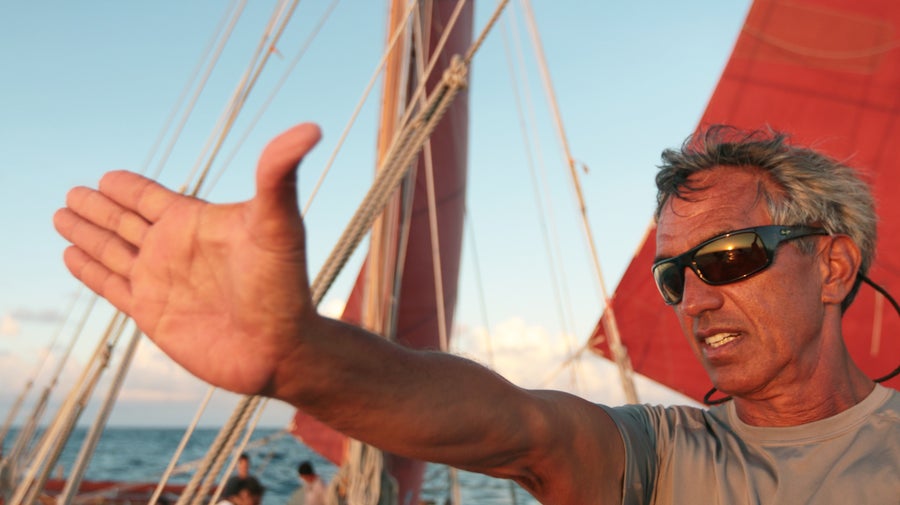
Master navigator Nainoa Thompson measuring the sun at sunset, which is one of the most critical times of day for non-instrument navigators. Credit: Ōwi TV, and Polynesian Voyaging Society
“If science is based on inquiry, observation and exploration, then the ancient Polynesians were supreme ocean scientists,” Thompson says. He adds, however, that navigators did more than just accumulate objective knowledge about the natural world. He tells the story of his teacher Piailug, whose grandfather (also a navigator) used to throw young Piailug into the sea so the boy could “know the waves from the inside.” According to Thompson, “The difference between Mau’s science and modern science is that modern science separates itself from its objects of observation. In Mau’s science you are the waves, you are the wind, you are the stars.” He contends this can lead to a state of “knowing without knowing how you know,” in which navigators can make the right decisions when there are few cues that others would find obvious.
The voyages of the Hōkūle ʻ a over the decades have been eagerly followed by islanders throughout the Pacific. Former crew member Sam ‘Ohu Gon, a senior science and cultural advisor for the Nature Conservancy of Hawaii, believes they have helped to restore pride in Polynesian culture, which had been suppressed during the centuries of colonial rule. “It sparked a realization that the peoples of the Pacific are not separated by the oceans but connected by them,” Gon says.
For example, the teaching of Hawaiian language in public schools was long banned, and according to Gon the last exclusive native speakers were dying in the 1960s. “But due in large part to the inspiration of these voyages, which have become a symbol of Hawaiian identity,” he says, “the language is now being revived and taught in high schools and language-immersion schools throughout Hawaii.” In 1996 Hawaiian was established as an official state language, allowing it to be used to draft documents and legislation.
Gon goes on to say the goal of the Hōkūle ʻ a voyages has shifted away from merely demonstrating the power of traditional knowledge to advocating for environmental protection. The latest round-the-world voyage, called “ Mālama Honua ” (which in Hawaiian means “to care for our island Earth”) aims especially to focus public attention on the worsening plight of the world’s oceans.
Thompson says he has seen big changes in the sea since he started voyaging in the 1970s. Nowadays when the crew fishes to supplement their diet, the catch is meager. “We recently sailed 1,100 [kilometers] from Mauritius to Madagascar without catching a single fish,” he says. “Fully 90 percent of the edible fish have already been taken out of the seas.”
Reefs, which feed and protect the inhabitants of small islands, are bleaching yearly in many places. Thompson finds a sense of gloom and depression has descended in many of these areas. “We’ve had so many painful conversations with folks who know they are going to lose their islands due to climate change,” he says.
Chip Fletcher, a coastal geologist at the University of Hawaii at Manoa who has served as one of Thompson’s scientific collaborators, believes “the immediate threat is not that sea level rise is drowning the atolls and low-lying islands of the Pacific but that saltwater is already bubbling up into aquifers, challenging the freshwater capacity on which coastal communities depend.”
Fletcher says sea level rise is happening three times faster this century than the average during the previous one, with some recent models suggesting levels in the Pacific may be two or even three meters higher by the end of the century. Dangerous hurricanes are also proliferating and moving into more temperate regions as warming causes the tropical zone to expand. Hawaii itself has experienced more frequent and larger storms in recent years, Fletcher says. And droughts, a real threat to freshwater-poor islands, are increasing as El Niño weather systems become more severe.
“The irony is that the Pacific islands have nothing to do with creating climate change but they are the ones who are suffering the most,” Thompson says. But he is optimistic that the looming crisis has sparked an unprecedented awakening. “It is the Pacific's time,” he says. "The good news is that we found thousands of people there full of aloha, full of compassion and caring for the Earth and for the oceans, which give us our life. The news from the Pacific is not good. Yet the spirit of the people we met on the voyage leaves me feeling incredibly strengthened and inspired.”
Yachting Monthly
- Digital edition

James Wharram: Eight bells for the multihull pioneer
- Katy Stickland
- January 7, 2022
Tributes have been paid to pioneering multihull designer and sailor James Wharram, who has died aged 93

James Wharram dedicated his life to to proving the Polynesian double canoe was an ocean worthy craft. Credit: James Wharram Designs
James Wharram, considered by many as the father of modern multihull cruising, has died, aged 93.
The free-spirited sailor and designer specialised in double-canoe style sailing catamarans, inspired by the Polynesian double canoe.
Born in Manchester in 1928, Wharram designed his first offshore cruising catamaran, Tangaroa in 1953 having read about Frenchman Éric de Bisschop’s 1937-1939 voyage from Hawaii to France in his double canoe.

Ruth Merseburger, later Ruth Wharram, was an early believer in James’s designs and theories and helped build his first multihull, Tangaroa . Courtesy: James Wharram Designs
Determined to prove the seagoing qualities of the double canoe, Wharram, accompanied by Ruth Merseburger, who later became Ruth Wharram, and Jutta Schultze-Rohnhof, sailed his 23ft 6 inch multihull from Falmouth across the Atlantic to Trinidad in 1956.
Wharram wrote about crossing the Bay of Biscay in Tangaroa for Yachting Monthly in 1956, going into details about the catamaran’s performance, easy motion and stability. This was in direct contrast to the then held opinion that a motion of a catamaran would be worse than on a keel yacht.
Three years later, having built the 40ft Rongo on a beach in Trinidad with the help of French sailor Bernard Moistessier, Wharram, Ruth and Jutta sailed to New York before crossing the North Atlantic – the first ever North Atlantic West-to-East crossing by multihull.

Onboard Rongo in the Atlantic with his son Hannes. Courtesy: James Wharram Designs
James Wharram started designing for self-builders in 1965.
Along with his partners Ruth Wharram and Hanneke Boon, he created distinctive V-hull double-ended catamarans, from 13ft to over 60ft, selling more than 10,000 sets of plans.

Jutta Schultze-Rohnhof and Ruth Merseburger with James Wharram before they left Falmouth onboard Tangaroa. Courtesy: James Wharram Designs
Wharram believed in a ‘less is more’ approach to boat building, and all of his boats are of simple construction, aimed at amateur boat builders, including the Tiki 21, Cooking Fat , which became the smallest catamaran to sail around the world when skippered by Rory McDougall from 1991-1997.
In May 1992, Wharram launched the 63ft Pahi, Spirit of Gaia , from his home on Restronguet Creek in Cornwall, sailing 32,000 miles around the world from England to Greece via the Pacific.

Spirit of Gaia. Courtesy: James Wharram Designs
The catamaran, which has a low freeboard and trademark Wharram Wingsail Rig, was conceived as a base ship for studying whales and dolphins at sea, able to accommodate 16 people offshore.
Continues below…

Wharram cats launched to search for ancestors
Lapita voyage boats launched in Philippines

60th anniversary of first Wharram catamaran to set sail from Falmouth
60 years ago, on the 27th September 1955, James Wharram set sail from Falmouth aboard a self-built 23ft 6in flat-bottomed
In 2008, Wharram’s career came full circle, when 50 years after his pioneering voyages, he sailed 4,000 miles on one of two 38ft double canoes along the island chains of the Philippines, Indonesia, New Guinea and the Solomons.

Sailing Spirit of Gaia. Courtesy: James Wharram Designs
Known as the Lapita Voyage , the canoes were based on an ancient Polynesian canoe hull-form, and were powered by sail alone, using traditional Polynesian crab claw sails and steering paddles.
Paying tribute to her life partner, Hanneke Boon wrote: ‘ James was a trailblazer, a fighter with great determination and vision. From a young age he followed his passions – to roam the hills – for fair politics – for intelligent women – to sail the seas – to prove the Polynesian double canoe an ocean worthy craft – to become a Man of the Sea.

With his life partners, Ruth Wharram, who died in 2013 aged 92 and Hanneke Boon. Courtesy: James Wharram Designs
‘These passions made him into a pioneer of catamaran sailing and a world-renowned designer of unique double-canoe catamarans that now sail the oceans.
‘He designed for people who wanted to break out of mundane lives, gave them boats they could build at an affordable cost and gave them the opportunity to become People of the Sea like himself.’

James Wharram preferred sailing to building and tried to make all of his design as simple as possible to build. Courtesy: James Wharram Designs
In the last few years of Wharram’s life he developed Alzheimer’s. He died on 14 December.
‘He could not face the prospect of further disintegration and made the very hard call to end it himself. It was with great courage that he lived his life and with great courage he decided it was the time to finish,’ wrote Hanneke
‘In this moment of great loss we should all remember the good and glorious times of a life fulfilled. This is not the end, I, we, all the Wharram World will keep his work alive.’
James Wharram 1928-2021
Enjoyed reading this?
A subscription to Yachting Monthly magazine costs around 40% less than the cover price .
Print and digital editions are available through Magazines Direct – where you can also find the latest deals .
YM is packed with information to help you get the most from your time on the water.
- Take your seamanship to the next level with tips, advice and skills from our experts
- Impartial in-depth reviews of the latest yachts and equipment
- Cruising guides to help you reach those dream destinations
Follow us on Facebook , Twitter and Instagram.
Log in or Sign up
You are using an out of date browser. It may not display this or other websites correctly. You should upgrade or use an alternative browser .
Canoe Catamaran
Discussion in ' Boat Design ' started by kmeastman , Dec 11, 2007 .
kmeastman Junior Member
I am a Mechanical Engineering student at the University of Nebraska-Lincoln. For my senior design semester project I would like to design a catamaran that is sail powered and uses two canoes as its two hulls. I have never designed a boat so I was hoping that more experienced people could help me out. The purpose of using canoes is mostly because the cargo/people capacity would be much greater than with most catamarans. I realize that this would make the boat slower than the average catamaran but I am ok with that. I was thinking along the lines of using 17' aluminum canoes, which usually come with two seats (each canoe), but a third would likely be added. It would likely be built to the maximum trailerable width of 8'6". I was thinking of having only one mainsail and probably adding a captain's seat between the two canoes toward the rear. I have done some preliminary research and here are the problems I forsee: 1. Since I am going to buy the canoes instead of building them, I can't get very good estimates of factors like wetted area and lateral plane area. I think I could figure them out if I had a canoe to take measurements on and then model it in a 3D CAD program. The problem is that I don't want to buy one and then find out that I need a larger or smaller one to make this work. 2. The major difference between a canoe hull and a catamaran hull is its width at the water level. Since the canoe is much flatter, it will have a large wetted area compared to its lateral plane area. I'm not sure how big of a problem this could be. I could increase the lateral plane area with the use of a center board but I would definitely have more overall wetted area and drag than an average catamaran. Again, I am not overly concerned about the speed I can get out of it, but it will hardly be worth putting a sail on it if its going to be too slow. 3. Catamarans that I have seen have similar L/B ratios to what I am talking about here. However, because a canoe is much wider than a catamaran hull, the center to center distance between the canoes would be much smaller than the center to center distance on a catamaran given the same L/B ratio. Is this a problem? 4. I was thinking that the boom of the sail would be mounted high enough that it would clear the head of the person in the middle seat (much lower than the other two seats) and the boom would not be long enough to reach the person in the back seat. In order for it not to hit the person in the front seat the rotation of the sail would have to be limited. Since the pivot of the sail and the front seat will likely be at about the longitudinal placement, this is about 180 degrees of rotation. From sailing books I have read, you should never need your sail to be rotated more than this but is there any reason why limiting its travel would be a problem? Any help is appriciated. If you have any advice on these problems or can think of any other possible problems I would love to hear what you think. Thanks Kevin
masalai masalai
Research on polynesian ocean voyaging and Melanesian ocean voyaging and some of the catamaran threads.
Pericles Senior Member
I concur. http://pvs.kcc.hawaii.edu/ http://www.pbs.org/wayfinders/polynesian2.html http://www.janeresture.com/voyaging/main.htm http://www.moolelo.com/hokulea.html http://starbulletin.com/2007/03/18/news/story04.html Masalai, Two minds with but a single thought. Pericles
Seasons greetings to you Pericles (God of ? remind me. I was endeavouring to maintain a "grumpy old *******" attitude and make him look for himself. Good exercise for the young wipper-snapper. eh eh eh
Village_Idiot Senior Member
A coupla things I would consider: 1) Canoes generally aren't used for catamaran hulls because they can take on waves/water and list/sink/capsize. If you're going to sail this thing in anything with over foot-high waves, you need to make the hulls shed water. Maybe try the FRP solid (sit-on-top) kayaks that have no interior. However, you will lose your room/capacity that you are trying to gain with the open hulls. 2) You can get around the 8.5' beam limitation by making the hulls movable under their scaffolding - once the boat is launched, move the hulls outboard to gain your stability. Depending on how wide you want the scaffold (deck), you can even go narrower than 8.5' to make trailering easier. 3) For truly innovative engineering design, use flat-transom canoes (that you can put an outboard on if you wanted), then design a configuration where you can swing one of the 17-foot canoes around backward so you can join the two canoes at the transoms and make a nice 34-foot canoe (remember, longer displacement hulls are faster and more efficient). This would give you a l/b ratio of around 11:1-12:1. You can add an outrigger for stability. Properly designed, you can turn the sailing cat into a fast outrigger canoe for when the wind isn't blowing. Maybe you could even design the mast, and/or the deck, to do double-duty as an outrigger. Or maybe just have an efficient fast-sailing canoe with a proper outrigger and sail combination...
Thanks for your suggestions, I have seen the polynesian sailing canoes that you are talking about, which is what convinced me that my idea would work. I have checked out some of the other threads on catamarans and have gotten some valuable info from them. I'll check out the specific websites that you reccomended. As for the canoes taking on water, I do not intend this to go on real rough water. It will probably always be used on inland lakes and probably not on water rougher than you would normally take a single manually powered canoe on. If the water became an issue, do you think you could put some kind of water deflector on the top edge of the canoe that would make splashing waves bounce away from the hull? As for the trailering, I have already thought about making the boat wider by sliding the hulls out after it gets trailered. I would like to avoid this but I haven't done enough calculations yet to make sure it would be stable without any extra width. I really like your idea idea about the 2 flat transom canoes. I had anticipated using the double ended ones but one of the whole purposes of this project is to have a very versatile boat. One of the design requirements is that it needs to be dissassembled to portage between two lakes. This way the canoes could still be used individually too. I like this idea of having an extra long canoe as another option. It could be used maunually powered or if I decided to add an outrigger could be sail powered. Also, I didn't really want it to have an outboard motor on it, but if I had the flat transom style canoe I would have that option in the future.
rwatson Senior Member
James Wharram designs sailing catamarans that are canoes - with a kyak like covered in seat in each hull
Petros Senior Member
Sounds like a fun project. How about one really large cargo carrying canoe (better l/w ratio), with a kayak outrigger (or even two kayaks to make a trimaran). The kayaks can be attached to the outrigger booms with quick and simple bungee cord mounts. That way you do not have to unpack the canoe to take one of the kayaks out to scout ahead or find a campsite, etc. You would have more flexibility as to the use of the hulls together or apart too. Under sail the passengers and cargo are all together, where your single rudder is located on the center hull. The sea kayak outriggers could also store cargo was well, or an extra passenger. It would also be easy and light to attach the outriggers after trailering so you can go much wider which is much better. You can carry more sail this way too. There is less drag with a larger distance between the hulls, so not only can you carry more sail, but lower drag too due to interference effect from closely spaced hulls. the rotation molded sea kayaks (called "Tupperware" kayaks) are cheap, get them used from craigslist. Or better yet, build skin-on-frame kayaks, quick, light and inexpensive. I've built seven, they have cost me $30 to $50 each to build (using salvaged lumber), even buying all the materials new would still only cost about $100 or so each. Mine weight only about 20 lbs complete (attaching something this light after trailering would be an easy task). The canoe can be built skin-on-frame as well, a lot less expensive and lighter than aluminum. BTW it is common to use fabric splash covers on river canoes to keep the water out, no reason that could be done on your canoes as well. Good luck.
Well, the project has been approved and is underway. My group was able to model the canoes and get some measurements like lateral plane area, Longintudinal center of buoyancy, LWL, and wetted area for different weights. I have done some estimates on D/L and SA/D ratios and they seem within reason for the kind of boat I would like to build. Most of the reccomendations for these ratios that I have seen are for monohulls. Would they be any different for a catamaran? Is there any books or websites that anyone can reccomend that give calculations or reccomendations that are specific to catamarans? What I would like some help with is how to determine if the lateral resistance area that I calculated is enough or if I need to add a centerboard. Also, what calculations can I make with the wetted area? Thanks for the help, Kevin
"Also, what calculations can I make with the wetted area?" You can calculate how wet the wetted area is ? Years ago, an old yacht designer told us kids about how to determine the centre or resistance without any math. He cut out a profile of the underwater hull from a piece of cardboard, balanced the shape on the edge of a ruler, and where it balanced, marked it as the centre of lateral resistance. It seemed to work back then. I always wondered if the profile he cut should have been the profile of the heeled yacht (would have had a curved top edge and a shorter keel), but that would not apply to catamarans. Does anyone else still use this or a similar technique these days?
FAST FRED Senior Member
There are plastic pontoons made that can be put together to most any length to build your basic boat.. The shape of the weted surface would be better than the canoe , and might even be cheaper. FF
The wetted area is used to calculate the drag. The less the wetted area the better, but in a canoe or monohull the smallest wetted area is a semi-circular cross section, which means no resistance to heeling moments. On a cat this matters little, so many cat hulls are semi-circular in cross section (for least drag) but if you use the hull as a canoe it will simply roll over. You need a flatter bottom so it has some inherent stablity,
There are very few cat hull that are semi circular in cross section! They are either bell shaped or sharp edged. The sides are flattened to resist leeway, and avoid the necessity of big daggerboards. Certainly the forward part of the hulls are almost knife shaped, for easy entry to waves and wind. Examples, Hobie Cat, Tornado (which has a semi circle for a small section of the stern), Nacra etc These features to enhance sailing ability will be far bigger considerations than a bit of friction on a small 16ft hull. due to wetted area.
Guest625101138 Previous Member
Kevin Get hold of a hull surface rendering program called Delftship. You can get a free version of it. Look at the hulls you are thinking of buying and draw approximate models in Delftship. This should take all of 10 minutes if you are a slow learner. If you are having trouble then post a couple of photos and I will spend the 5 minutes to do them for you. Delftship will provide you all the hydrostatic information. It will give you crap hydrodynamic data. However you can export the hull into Michlet format and then use Michlet to get accurate drag information - within 5% for a canoe type hull. With a sailing cat you can design for many cases. The two extremes is where you have both hulls equaly loaded on say a beam reach. The other extreme is where the entire weight is carried on a single hull when you are pushing hard to windward. There are obviously a whole series of load cases in between but looking at resolving the forces under these two extremes will give you a good understanding. If you want help on the detail after you get started, just post specific questions that are giving you difficulty. Rick W.
- Advertisement:
rwatson said: ↑ There are very few cat hull that are semi circular in cross section! They are either bell shaped or sharp edged. The sides are flattened to resist leeway, and avoid the necessity of big daggerboards. Certainly the forward part of the hulls are almost knife shaped, for easy entry to waves and wind. Examples, Hobie Cat, Tornado (which has a semi circle for a small section of the stern), Nacra etc Click to expand...
2 person Small Solar powered catamaran. Pedal board. Wood canoe
Do homebuilt kayaks & canoes need hull identification numbers in the U.S.?
Solo Canoe Camper concept: one or two outriggers?
Nesting canoe
Canoemaran, catcanoe
Child size kayak/canoe.
Modular canoe
can a boat be a canoe, kayak and sliding seat rower?
10m, 10 passenger canoe for use on Amazon River
Exofish!....a WIG canoe
- No, create an account now.
- Yes, my password is:
- Forgot your password?


COMMENTS
Outrigger fishing canoes are also used among certain non-Austronesian groups, such as the Sinhalese in Sri Lanka, where they are known as oruwa, [10] as well as among some groups in the Andaman and Nicobar Islands. [11] They can also be found in East Africa (e.g., the ungalawa of Tanzania).. The acquisition of the catamaran and outrigger boat technology by the non-Austronesian peoples in Sri ...
Food & Drink. WhiskeyBeerRecipesCocktails & SpiritsHealthy FoodWine. Windbound with a big lake crossing ahead, the crew decide to rig a canoe catamaran.
2) Catamaran two or more canoes together with cross-supports, keeping a distance of two feet between canoes. 3) Rig a single mast or an inverted "V." Make sure the mast is tied off securely. 4) Tie a tent fly or a kitchen tarp to the gaff pole and lash it to the top of the mast. The loose bottom corners of the sail can be tied off to the ...
Affordable. Building your own boat with Wharram Designs is the easiest and most cost effective way to fulfil your sailing dreams. Wharram Self-build boat plans start from only £120. Wharram designs are based on years of practical, hands-on experience of building and ocean sailing catamarans. They are renowned for their seaworthiness, stability ...
Catamaran Canoe. As we remember the days of old when Seagull Lake was entirely accessible by motor boat, we think of great fishing holes and beautiful scenery. But with the new motor restrictions on Seagull, we've been forced to get creative in order to fish those holes with the ease of years past. And we've come up with the double canoe raft.
4 - 2″ stainless steel U bolts with lock nuts and washers. 4 - 5″ stainless steel eye bolts with lock nuts and washers. 1 - 8′ 2×4 (or a couple of 8″ scraps) 2 - 8″ 5/8×16 bolts with lock nuts and washers. 4 - Ratcheting straps. I also needed a rubber mallet, wrenches, a drill, a set of drill bits, and a table saw.
Catamaran. The catamaran vessels of today are the direct descendants of the highly evolved Polynesian sailing canoes. Double-hulled canoes had two essential qualities: good buoyancy and stability, and these two qualities led to the development of the modern catamaran. Early attempts at building catamarans started in 1662 when Sir William Petty ...
A catamaran is a design for a boat that utilizes two hulls. Due to the flat, platform-like-potential for the deck of the boat, the catamaran is often purposed with transporting materials, vehicles, and people. For instance, catamarans are quite often used as ferries.
The catamaran hull design creates a space for storing any gear or safety equipment. Whether traveling to a nearby lake or embarking on a distant adventure, the Flip-Kat® simplifies the process, making it effortless to bring your kayak along. noisyriveroutdoors. 2,848 followers.
People of the Sea, by James Wharram with Hanneke Boon, 2023. James, partnered by two German women Ruth and Jutta, designed and built Europe's first successful offshore catamaran, the 23ft wooden , in 1953-54, then crossed the Atlantic Ocean on this same vessel in 1955-56. The snobby British yachting world remained indifferent; Wharram's ...
Seagull Canoe Outfitters. Debbie Mark & Staff. 12208 Gunflint Trail. Grand Marais, Minnesota 55604. For a free brochure or to make a reservation: : 218-388-2216. : A Canoe Trip for a family with small children starts with planning a Catamaran Canoe Trip. Plan your next great family adventure with Seagull Outfitters.
The dugout canoe in this configuration, with only one ama, will not be a 100% safe boat. Instead we will transform the canoe into a trimaran. The Va'a Motu association reconvened to re-elect a ...
A Formula 16 beachable catamaran Powered catamaran passenger ferry at Salem, Massachusetts, United States. A catamaran (/ ˌ k æ t ə m ə ˈ r æ n /) (informally, a "cat") is a watercraft with two parallel hulls of equal size. The distance between a catamaran's hulls imparts resistance to rolling and overturning. Catamarans typically have less hull volume, smaller displacement, and ...
E ho'okele kakou! Come experience Kamoauli, a traditional Polynesian wa'a kaulua - an all-wood, double-hulled sailing canoe! Kamoauli is dedicated to preserving and perpetuating Hawaiian culture by offering a unique educational platform to share ka moʻōlelo o ka 'āina - the native history, myths, legends and stories of Hawaiʻi. We offer a culturally immersive travel experience at sea along ...
Importantly, double-hulled canoes (catamarans) were also popular amongst the early Polynesian people. Today, many original style wooden vessels can be found on the waters, but more often we have seen Polynesian outrigger canoes made from modern materials. However, the basic long narrow shape with the addition of only a single outrigger has ...
James Wharram Designs are designers of unique double-canoe style sailing catamarans inspired by the canoe craft of the Pacific. They have their headquarters on the shore of Restronguet creek in Devoran, Cornwall. James Wharram was the pioneer of offshore multihulls, making his first Atlantic crossing by catamaran in 1956 and the first.
Hawaiian Canoe Sailing Tours. Sail a traditional Hawaiian canoe on Hilo Bay in the moonlight, experience the pristine beaches and rugged cliffs on the Kona coast, hike along the shore on a path in the lava where the Hawaiians have walked for centuries, explore steam vents and black sand beaches. Wa'akaulua is the Hawaiian word for double hull ...
The Holopuni Iako-Trimaran set uses 2 amas that are rigged out at an equal distance from the hull. This is our favorite and recommended sailing set up. Our iako design was created through years of R&D and consultation. All canoes are hand-built and custom-made to order. The OC3 SAIL has a stronger lay up than the OC3 Paddling Canoe.
Hobie's fiberglass beach-launchable catamarans revolutionized sailing. Fly a hull and you'll understand the global obsession. Hobie 16. Mirage Islands. Hobie Mirage Island trimarans are multi-mode performers: sail, fish, pedal, paddle. Yet approachable thanks to the hands-free power of the MirageDrive 180.
On June 17, a 62-foot-long double-hulled canoe is slated to arrive in Honolulu, completing the first-ever round-the-world voyage by a traditional Polynesian vessel—a predecessor of the modern ...
The free-spirited sailor and designer specialised in double-canoe style sailing catamarans, inspired by the Polynesian double canoe. Born in Manchester in 1928, Wharram designed his first offshore cruising catamaran, Tangaroa in 1953 having read about Frenchman Éric de Bisschop's 1937-1939 voyage from Hawaii to France in his double canoe.
James Wharram's First Catamaran Build. James Wharram. Jul 2, 2021. Ruth aboard Tangaroa shortly after the boat's initial launch. More than just a sailor and designer, James Wharram, originally of Manchester, England, is also both a free-thinker and an individual clearly dedicated to getting as much out of this life as possible.
1) Canoes generally aren't used for catamaran hulls because they can take on waves/water and list/sink/capsize. If you're going to sail this thing in anything with over foot-high waves, you need to make the hulls shed water. Maybe try the FRP solid (sit-on-top) kayaks that have no interior.